It seems we can’t find what you’re looking for. Perhaps searching can help.




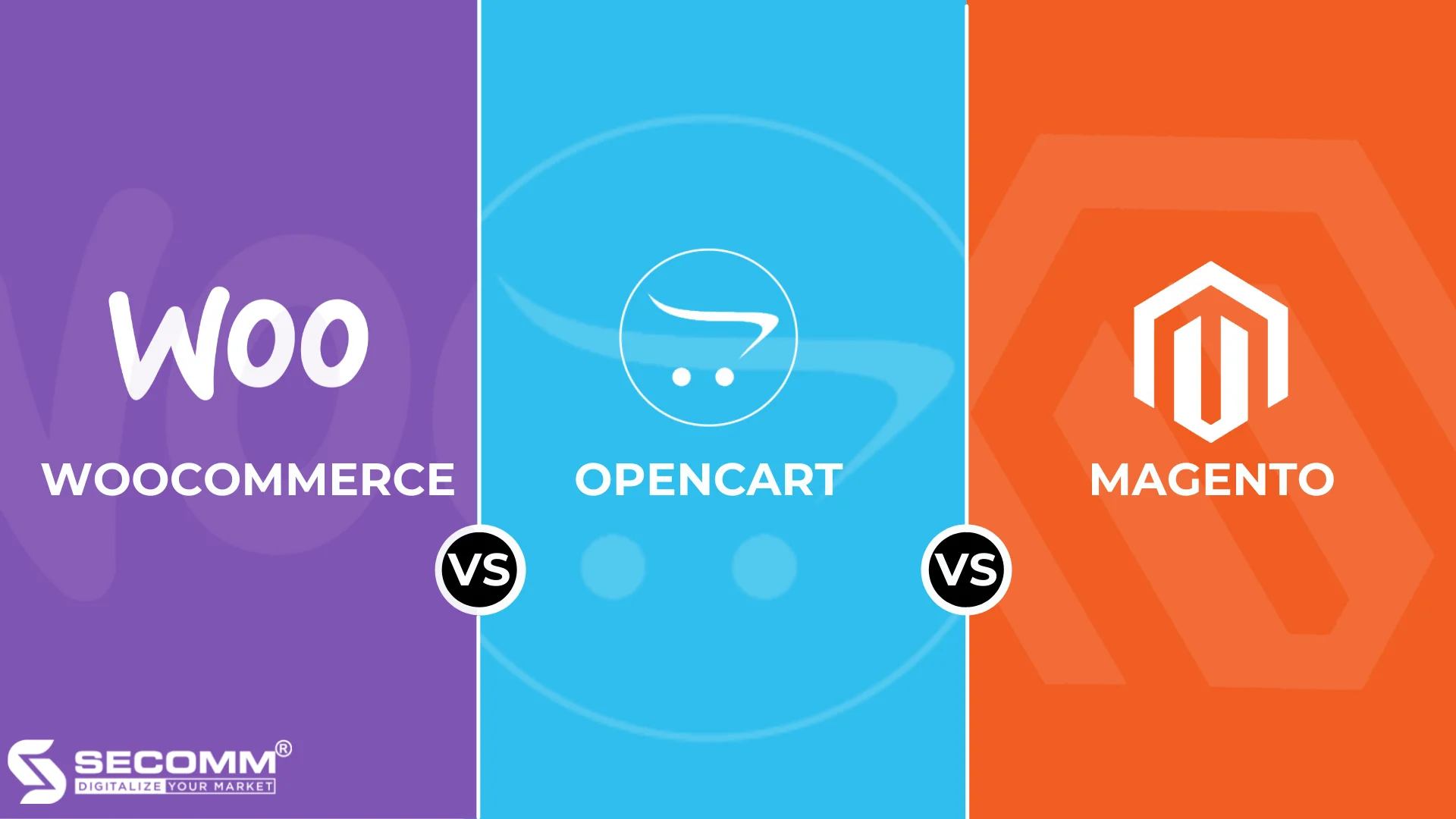
3 POPULAR OPEN-SOURCE ECOMMERCE PLATFORMS: WHICH IS YOUR BEST CHOICE?
It’s important when it comes to choosing the right platform to build an effective eCommerce system. Businesses have many options to choose from either the open-source eCommerce platforms or any eCommerce platform as a service (SaaS, Paas), depending on the eCommerce business model and business plans.
To have a comprehensive eCommerce system, the open-source eCommerce platform is the business’s best friend, because of the great flexibility, scalability, customization according to the products, and catalogue characteristics.
In addition, the open-source platform also allows businesses to own the entire system source code and data. With all of these outstanding features, open-source platforms are slowly becoming the eCommerce development choices that many businesses are aiming for.
However, businesses need to carefully consider choosing the right platform. There are a lot of open-source eCommerce platforms on the market (OpenCart, WooCommerce, Magento,…), and each platform has its pros and cons.
WooCommerce
WooCommerce is a WordPress plug-in introduced in 2011, completely free, and allows businesses to turn their WordPress sites into online stores, with built-in and additional features.
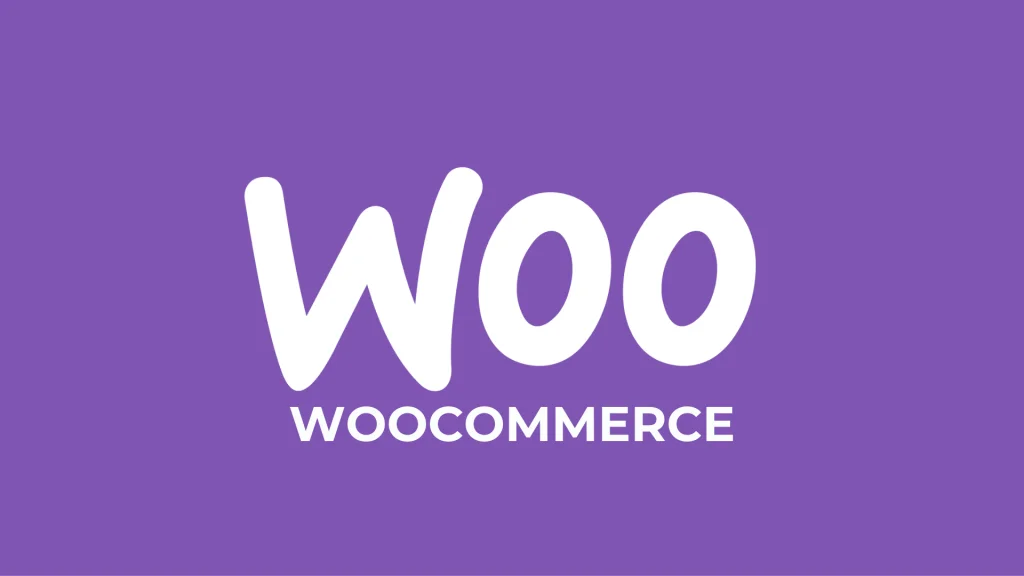
Pros
Ease of use
Many businesses that have been using WordPress for their online business, must be familiar with WooCommerce. Businesses can turn their website into an eCommerce system when implementing the WooCommerce Plugin into their WordPress website easily.
They can set up, integrate, and adjust functions on themes, and add-ons,… that have been built with high functionality from developers in a strong community around the world, making it easier to modify, and more flexible on the platform
In addition, WooCommerce is carefully built, convenient, also has huge and rich theme storage, and it is easy for businesses to design and build an e-commerce system right from the start, without knowing too much about technology.
Rich in features and add-ons
WooCommerce allows and supports features such as product management, orders, inventory, search engine optimization (SEO), discounts, sales, statistics reports, easy integration of payment units, shipping, handling units, and shopping experience optimization on all devices, making it easy for businesses to build a comprehensive system for simple and effective e-commerce business development.
Regarding security, WooCommerce ensures that businesses have the best security through a regularly updated system, and also ensures all of the business transactions are secure and safe through the features from the third-party services.
Cons
Low performance
One of the biggest disadvantages for businesses using the WooCommerce platform is the low performance, the system is easily overloaded with plug-ins and themes, and the number of products does not surpass 2000 SKUs, and often affects the system if the number of products exceeds the limit. Therefore, when businesses want to expand their business, it is necessary to consider switching to another platform.
Limited customization
WooCommerce is a plugin for WordPress, the platform lets businesses customize their eCommerce system, but building a complete, and comprehensive eCommerce system with unique features is very limited. The modification can cause instability for the system as well as the possibility that those built-in features are not compatible with the platform.
To customize a suitable system based on the available features system, businesses will face many challenges, it takes a lot of time and resources.
WooCommerce is perfect for businesses that are using WordPress and are looking to develop an e-commerce system. However, WooCommerce is not perfect for developing a comprehensive e-commerce system and expanding the business model. Some brands are using WooCommerce around the world such as Pluralsight LLC, and Gordon College, and famous brands in Vietnam such as Vietnam Airlines, Pharmacity, etc.
OpenCart
OpenCart is an open-source CMS (Content Management System) using PHP language, similar to WordPress but specially designed for e-commerce.
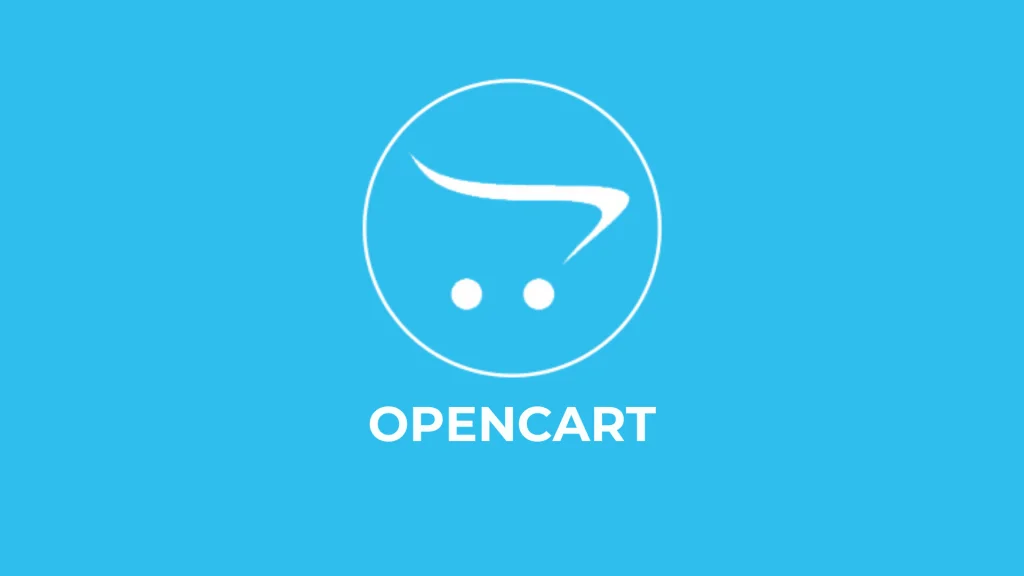
Pros
Friendly interface and easy-to-use
OpenCart provides an intuitive, easy-to-use, friendly interface, which is specialized for
the eCommerce industry. In addition, OpenCart also provides a completely free variety of interfaces and features, making it easy for businesses to develop e-commerce systems with basic website development knowledge and skills. Because OpenCart is built based on the MVC Model (Model- View- Controller), developing and writing a module for an e-commerce system on this platform is also quite easy.
Full of basic e-commerce features and a variety of add-ons.
OpenCart supports businesses with every basic e-commerce feature. Since OpenCart is a CMS specially designed for e-commerce, the open-source commerce platform such as OpenCart fully supports basic e-commerce functions such as sales, sales management, data management, statistics, customer data lists, and invoices.
Businesses can easily create and manage many different stores on the same system without having too much technical knowledge. This also means that businesses can access and manage all data of multiple stores at the same time with just one single central OpenCart system.
Not only supporting businesses build and manage an eCommerce system, but OpenCart also supports marketing such as search engine optimization (SEO), keyword advertising (Adwords), marketing programs, and affiliate marketing programs to be able to reach customers more easily, increase sales on the eCommerce system.
On top of the basic e-commerce functions, OpenCart also has additional applications to support businesses such as daily business operations and product categories. The backup and restore function helps businesses always have a backup system in hand and ready to restore all of the data on the system in case of an emergency
Besides that the platform also has many features such as a shopping cart, support customers to buy many products at once; gift features issuing gift cards, and loyalty programs. In addition, businesses can integrate other utilities such as payment gateway VNPay, and PayCEC, to help businesses have a better, faster, and seamless shopping experience.
Customization
With all of the basic features of an open-source program, businesses can easily modify, edit and customize on the OpenCart platform. In addition, the OpenCart e-commerce platform has a great ecosystem with many functions suitable for e-commerce business, firms can fully explore, as well as develop modules that are suitable for a satisfactory e-commerce system.
Cons
Although the OpenCart platform has many advantages that are the best fit for e-commerce businesses, there are also some limitations that businesses should be aware of when using the platform.
Low performance, and unstable
Although the platform is highly rated and well designed for the eCommerce industry, the system is still not stable enough because the modules and functions are not fully optimized, many errors occur while operating, as well as the installation steps are still very perplexing.
Therefore, businesses still encounter many problems when building and operating, which might affect the business’s processing speed as well as the revenue.
Feature development costs can become expensive
OpenCart owns extensive storage with quite a lot of basic features to serve e-commerce businesses quickly and conveniently, but the platform still cannot meet the advanced and specialized features according to specific product characteristics, product categories, and business needs of each field.
Therefore, businesses will need to invest time and resources to develop advanced features. For example, the SEO feature is supported on the platform, but there are many difficulties when censoring content via Google, not as effective as on the WordPress platform.
The OpenCart platform is relatively new compared to other platforms on the market, has many limitations and needs to be optimized. Similar to the WooCommerce platform, this is a good platform to start an ecommerce business, but not perfect for developing a comprehensive ecommerce system that goes along with growing and scaling your business. Some of the international brands that are using OpenCart such as Sunglass Hut, Virgin Enterprise, Audio-Technica Ltd, and the brands in Vietnam that are using OpenCart are Mobifone, RitaVo, etc.
Magento
Magento is an open-source platform specially built for e-commerce. It is recognized as one of the leading e-commerce platforms today, offering various outstanding advantages such as high flexibility, a diverse ecosystem, and optimal security. Currently, Magento has two versions: Magento Open Source (free) and Magento Commerce (paid).
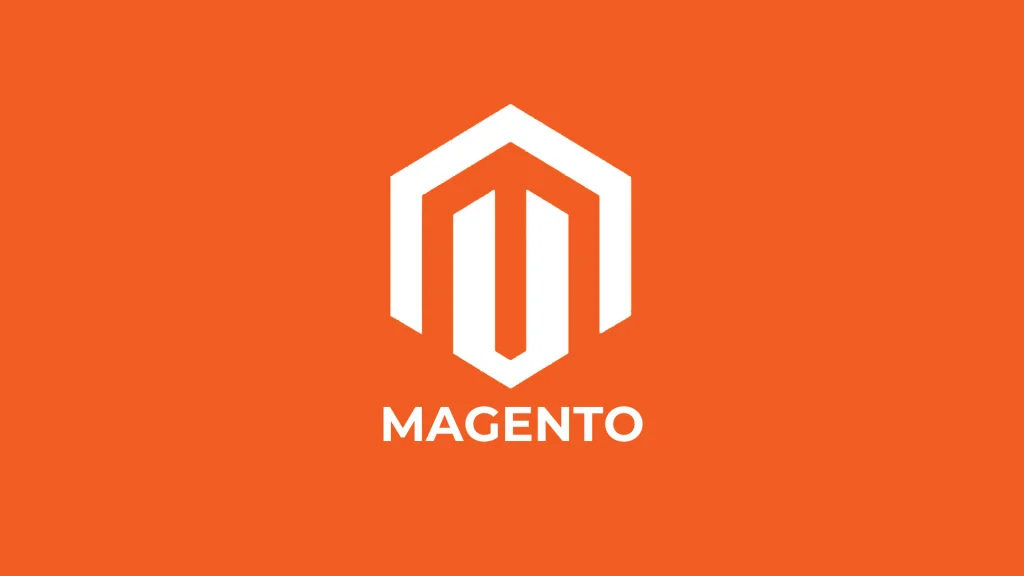
Pros
Diverse features for e-commerce from basic to advanced
Magento possesses many features available from basic to advanced to develop a complete e-commerce system including Category Management, Content Management, Customer Management, Marketing Management, Order Management, Store Management, System Management, Shopping Cart and Checkout, Reporting & Analytics. These features have been built with flexibility, and high availability to deliver outstanding results when integrated into the system, meeting all of your business e-commerce operations and sustainable growth needs
Scalability
One of the biggest fears of all ecommerce businesses is having a slow, poorly functioning system, or being overwhelmed when there are too many SKUs. With Magento, businesses do not need to worry about these issues even with millions of SKUs or thousands of transactions per hour. Magento can meet all the operational requirements, and business sustainable e-commerce development needs, with the ability to handle up to 500,000 products, and thousands of transactions in an hour.
High flexibility and customizability
Owning all of the advantages of an open source ecommerce platform, Magento has outstanding flexibility and customization. Businesses can easily change and develop new and specialized features according to the characteristics of products, industries, and businesses to be able to catch up with the rapid change of the market.
On top of that, businesses easily integrate third-party systems such as payment, shipping, POS, ERP, CRM, PIM, and BI to help develop all resources, and seamless processes without affecting the level of production, and the performance of e-commerce systems.
A global community for technical support and consulting
The customer support from Magento is for the customers, who are using the enterprise version, Magento Commerce. For customers, who are using the free edition, of Magento Open Source, there will not be any customer support from the platform.
However, Magento has a strong global technical support and consulting community. Therefore, most of the problems in eCommerce that businesses are facing can be solved from the Magento ecosystem or extensions from a third party. Having a strong global technical support community is also a testament to the level of reliability, quick resolution, and constant updates that Magento open source platform brings to customers.
Cons
High development costs
Magento open source e-commerce platform is highly appreciated with outstanding functions to develop a sustainable commerce platform, but businesses need to invest significant resources to deploy and develop the system.
Magento is an open source platform built specifically for e-commerce. This is known as one of the leading eCommerce platforms today on the market with many outstanding advantages such as high flexibility, diverse ecosystem and optimal security. Currently, Magento has 2 versions: Magento Open Source (free), and Magento Commerce (paid).
Magento has several outstanding features to develop a complete e-commerce system, and become a one-stop-shop for businesses that need development:
- Flexible Content Management: easy to adjust, and build many content management features on the e-commerce system.
- Mobile-Friendly Configuration: The interface and design of the Magento e-commerce platform are very suitable for smartphone and tablet devices.
- Advanced Search Engine Optimization: With effective SEO optimization, Magento gives online stores many opportunities to boost sales.
- Regulating Security Rights: Magento supports businesses to customize many levels of security permissions, control internal access rights, ensure system safety and protect users’ rights.
High Scalability
The biggest fear of all e-commerce businesses is having a slow, poor-performing website, or being overloaded with too many SKUs. With Magento, businesses do not need to worry about these issues, whether they have millions of SKUs or thousands of transactions per hour. Magento can meet all business needs for sustainable e-commerce operation and development. Therefore, businesses can scale up their business with Magneto.
High flexibility and customizability
The fact that the Magento platform has a high degree of flexibility is because of an open source platform. Businesses can modify and customize the templates, as well as adjust the features that the business needs to operate. In addition, businesses can completely build features from scratch to have an e-commerce system that is most suitable for businesses.
On top of that, businesses can easily integrate third-party systems such as ERP, CRM, and payment methods without affecting the level of performance of the main e-commerce system. In addition, businesses can easily separate the front-end interface from the back-end commercial activities.
Magento is an ideal place for businesses to host their software, but also a place with a lot of features. If your business currently has an experienced developer, or finances to attain a developer, and is ready to have an impressive e-commerce system, then Magento is a good choice. You have complete freedom to adjust the features until you are satisfied with your e-commerce system.
Big developer’s community around the world
However, the customer care from the Magento e-commerce platform is completely absent, in addition to that, Magento has a global developer support community. Therefore, there will be a lot of support for businesses to solve problems, and related techniques, as well as advice on building the most suitable solutions for businesses anytime, anywhere, and of course with a fee.
Cons
High development cost
A fully functional ecommerce system for a business is estimated to be at least $20,000 annually or more. If your business is just getting into e-commerce and has absolutely no technology experience, choosing Magento is a risky choice. But if businesses have the capacity and resources to run the system with this platform, then business growth will be faster with additional features such as sales automation.
Fully functional enterprise versions are estimated to be at least $20,000 annually or more. If your business is just getting into e-commerce and has absolutely no technology experience, choosing Magento is a risky choice. But if businesses have the capacity and resources to run the system with this platform, then business growth will be faster with additional features such as sales automation.
Complexity of specialized functions
Many businesses currently still face difficulties when transforming to e-commerce because of the specific characteristics of different industries and fields. These specific functions require an appropriate technology solution to ensure that the ecommerce system can operate efficiently and sustainably after the transformation. To build a specific feature with high complexity for an e-commerce system, businesses will need to spend more resources and time than the usual plan that businesses have set out to get a solution that fits the specific requirements of your e-commerce business.
Vietnamese firms that are using Magento
Magento is the best-fit solution for small and medium B2C businesses that have the need as well as the time, manpower and skills to build an e-commerce system. Famous brands in Vietnam are using the Magento ecommerce platform: Sendo, Vietnamworks, SJC, etc.
So which ecommerce platform is best suited for your business?
Different e-commerce platforms offer different features and values. No matter what route your business follows when building your e-commerce system, always think carefully about the following factors:
- The platform you choose must ensure your website is constantly updated and managed
- Choose a good web hosting
- Intuitive and seamless payment processors and shopping cart
- Good for customer service and user experience
- Ensure security for your site and customers’ data
BigCommerce
With BigCommerce, businesses can choose the price that suits their business needs. In addition, the BigCommerce eCommerce platform is designed for everyone to use, from beginners to professional developers. However, if the business does not have a lot of capacity, as well as finance, then using BigCommerce to develop an e-commerce system is not suitable.
WooCommerce
With the WooCommerce ecommerce platform, businesses have full control over the ecommerce system. In addition, businesses can freely compare, and adjust any functions in the ecommerce system. However, expanding your business on the WooCommerce platform would be an inappropriate choice, as the platform can be overloaded with functions on the ecommerce system. However, businesses can start an ecommerce system with WooCommerce with less investment than competitors like BigCommerce.
Magento
Magento is a comprehensive ecommerce platform capable of supporting businesses to expand and grow their business in all aspects. However, all the disadvantages of Magento can be narrowed down to a single problem: the technical challenges, which require businesses to have an in-depth programming team. Meanwhile, businesses can solve this by having a team with experience building e-commerce systems.
Businesses can contact SECOMM to receive detailed advice for the journey to develop a comprehensive and sustainable e-commerce system for businesses and consult Magento solutions specifically for SMEs in Vietnam!
 2
2

 11,575
11,575

 0
0

 1
1
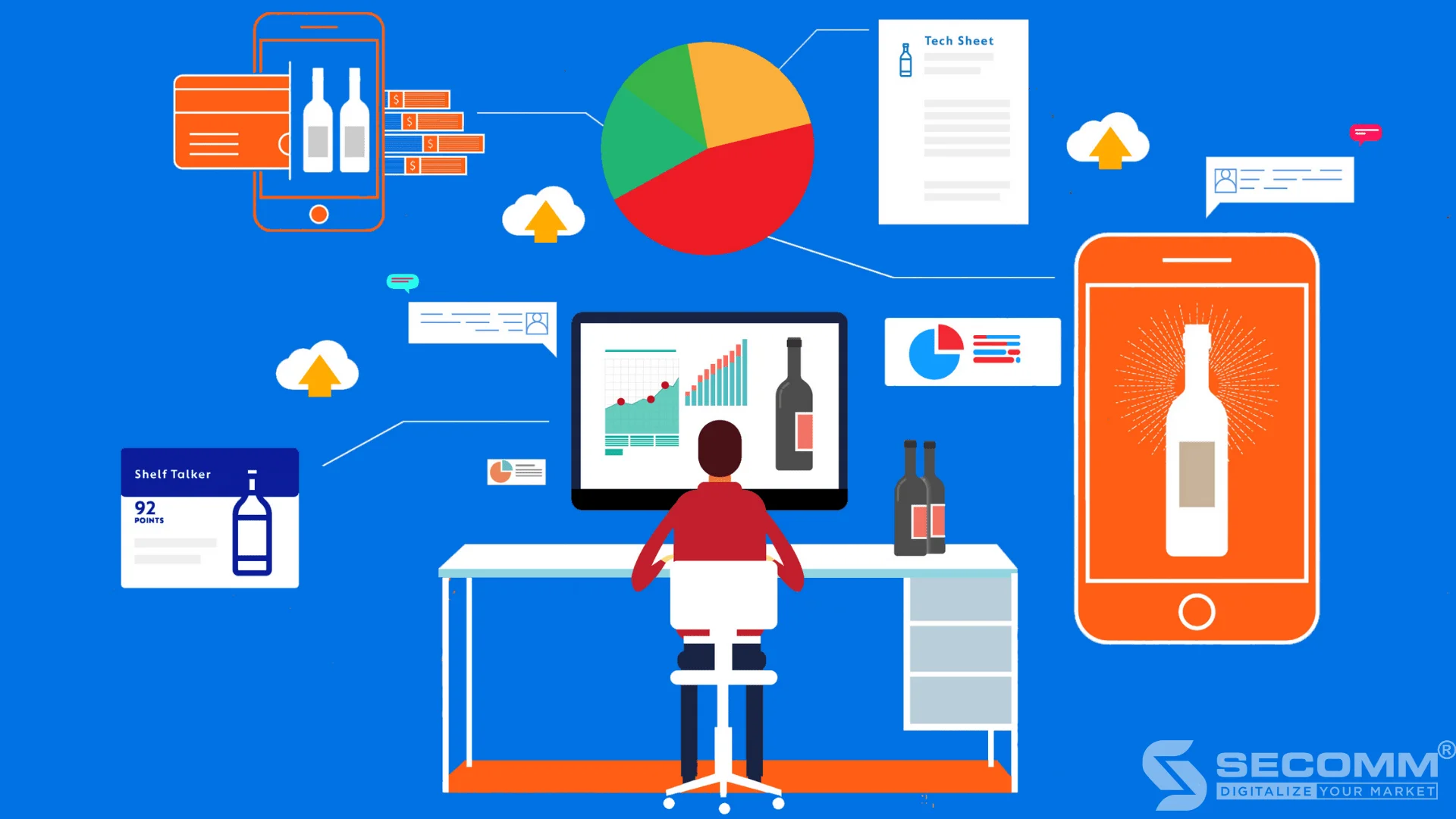
MAGENTO, AN ECOMMERCE PLATFORM TO KICK-START WINE ECOMMERCE TODAY
During the period of digital transformation and the strong impacts of the COVID-19 epidemic on the international markets as well as in Vietnam, the requirement to kick start and expand the eCommerce channel of the wine industry has accelerated faster than ever.
According to Nielsen, contrary to the expectation of a downward trend during the COVID-19 epidemic, the amount of alcohol sold through online stores during the Covid-19 epidemic increased by 27.6%. Particularly in Vietnam, many reports show that wine import volume in the past 3 years has always increased by 10% above average per year and tends to increase rapidly in the coming time, one of the reasons for the increase in wine imports is the changing trend from familiar alcoholic drinks to wine (Thanh Nien News).
However, to seize opportunities and deploy an effective eCommerce system for the wine industry businesses have to choose the most appropriate platform meticulously. Besides the platform that must match with the business model and the business plan, flexibility, and high scalability are the top two most important factors. Out of many highly-rated eCommerce platforms, the open-source Magento platform is well-chosen by many Wine eCommerce giants.
So how did Magento solve the eCommerce problems for the wine industry?
Special eCommerce requirements for the wine industry?
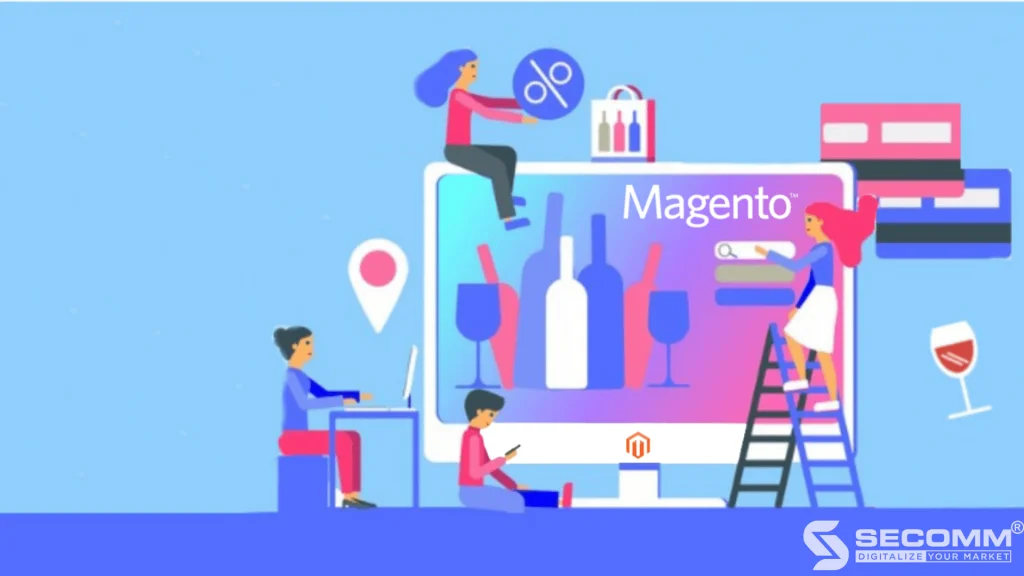
A modern user interface
The eCommerce system for the Wine business not only needs to have a neat interface, and match with UX/UI standards but must have a high aesthetics level, and bring out the most unique characteristics of the industry to convey the brand and the production values to the specific customer segment of the industry – customers with “style”.
In addition to investing in high-quality images, arranging the layout scientifically and conveniently, such as the display of new arrivals, best-selling products, and most viewed products right on the homepage of the online store, the interface should reflect the distinctive characteristics of the industry and the unique highlight from the business to the customers.
A functional system with high complexity
One of the biggest challenges when implementing eCommerce in the wine industry is the system’s high complexity.
Most eCommerce businesses in the wine industry own a complex category system with a diverse number of products and a variety of product attributes. In addition, to ensure that the eCommerce system is running smoothly and stably with the number of visitors entering the system increasing gradually over time, and spikes during many promotional campaigns, the eCommerce system also needs to be well-designed and built carefully.
Furthermore, many wine business owners often have many sales channels and use many different management software such as POS, CRM, and ERP… this requires eCommerce platforms to be able to integrate, seamlessly and efficiently with third-party software without affecting individual system performance.
This integration also helps businesses overcome the limitations of manual operation, and increase automation for back-office, and sales management processes, ensuring high accuracy and operational efficiency for business operations, and development.
To ensure the development and operation of a complex eCommerce system that meets the above characteristics required the developers of the eCommerce system for the wine industry must be experienced and highly skilled.
A seamless user experience
- A complete buyer’s journey experience
One of the most important factors for eCommerce is the customer experience. Especially for the wine industry, which relies on personal interactions to build relationships with customers. However, the digital transformation that has been taking place in the wine industry since the beginning of the Covid-19 pandemic means that the in-store shopping experiences are limited, in exchange for buying wine online through an eCommerce website.
Therefore, businesses need to ensure that they have a product information management system ready, products in stock, pricing displays, well-known brands, various payment options, and delivery services to give customers a complete shopping experience.
- Personalized user experience
Not only have a system that delivers a complete experience on the buyer’s journey, but businesses also need to prepare to personalize the customer experience. Beginning the personalization from the content, the product displacement, to navigating the buyer’s journey will be the key to helping businesses score points in the consumers’ eyes, effectively boosting sales and building Customer Lifetime Value (CLV) for the brand.
This requires businesses to know how to leverage unique data on consumers that has already been calculated and developed by using cutting-edge digital technology to build specific customer profiles, create buying habits that match the consumer’s interest, also provide customized content that matches each consumer’s needs, and bring a unique shopping experience to each customer when buying products on the system.
- Multi-channel customer experience
Nowadays, besides the traditional way of buying goods offline, or through brick-and-mortar stores, shopping through mobile applications as well as through websites has become a common way. Having a business presence on multiple channels – in other words, integrated Omni-channels makes it easy for users to make purchases.
To deliver a seamless multi-channel experience, it is essential to ensure that each channel is optimized for operation, nondisruptively connecting through technological infrastructure improvements. Simultaneously, businesses also need to ensure that they have enough customer information and take full advantage of these data to build distinct competitiveness, ensuring a seamless experience on the system.
In addition, wine businesses must constantly develop technology to accompany generations of customers that have changed over time from the Baby Boomers (1946-1964), Gen X (1965-1980), Millenials- Gen Y (1980-1996), and lastly Gen Z (1997-2002). The customer segments are getting more complex by the day, requiring businesses must have a solid understanding and stay up-to-date with technology to optimize the system to bring the best shopping experience that is most appropriate for each generation.
Related article: Wine eCommerce shines brilliantly in the digital era
Magento – Solutions for wine eCommerce
Magento is known as one of the leading eCommerce platforms for the wine industry with many outstanding advantages such as an open-source platform with high flexibility, a diverse ecosystem, optimal security, and owning all built-in features from basic to advanced for the eCommerce system.
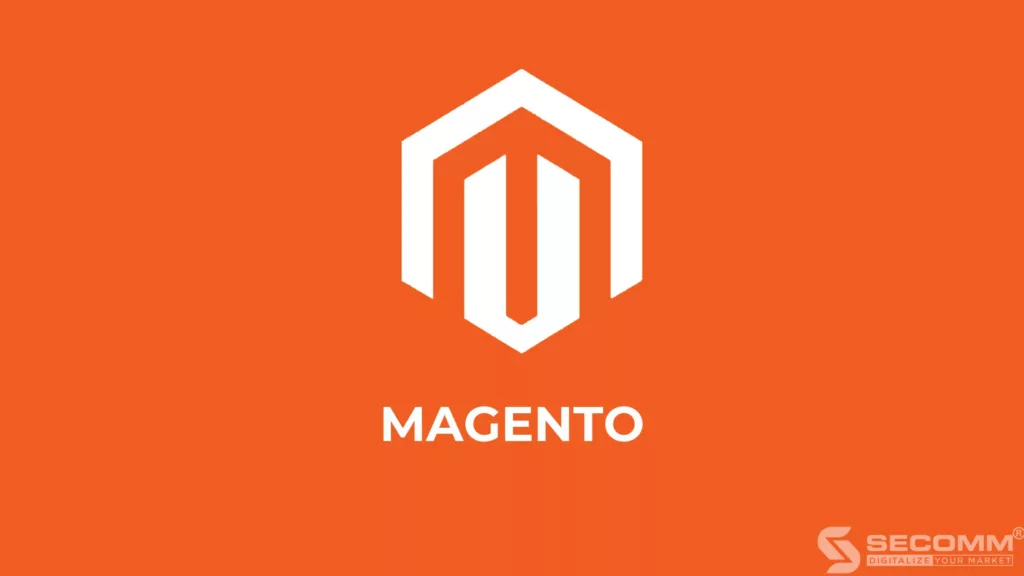
Owning all built-in features from basic to advanced for an eCommerce system
Basic features
The Magento platform owns an extensive ecosystem that contains many online features that support business in the wine industry such as managing customer information, handling wine allocation, and controlling inventory, as well as handling orders, etc.
- Catalog Management: Develop and control all data that possess all product features, categories, attributes, pricing system, inventory, and media (images and videos) to maintain operation and optimize business performance. Especially for the wine business that needs high-quality images representing different wine brands on the system, as well as different price systems on different websites.
- Content Management: Develop and enhance all content elements for CMS pages, media storage, theme customization, and web design, which helps businesses approach the consumer with nice personalized user and store interfaces.
- Sales Management: Set up and operate sales, order, payment, and shipping processes. It is simultaneously diversifying information to deliver the best customer experiences.
- Marketing Management: SEO optimization, marketing promotions implementation (promotion, upselling, cross-selling,…) with supporting tools to help businesses have more presence on digital platforms and boost sales.
- Customer Management: Fully manage customer data to improve marketing performance, and buying experiences, and enhance customer experience. Businesses can fully develop a personalized customer experience.
- Inventory Management: Easily fulfil the supply chain with inventory management tools, and distribute transportation to the proper warehouses that analyze subsequent efficient warehouses. This allows businesses to see exactly how many goods they have in stock.
- Report: Effectively exploit data through comprehensive and detailed reports to improve and enhance business performance, including Marketing Reports, Purchasing/Procurement Reports, Customer Reports, Product Reports, Review Reports, and Operating Performance.
- Analytic: Support monitoring and measuring eCommerce performance through integration tools, such as Google Analytics, and Facebook Pixels và Google Tag Manager (GTM). These analytics tools help to track and report web traffic, audiences, purchasing process, and buying behaviour, simultaneously help to measure ads performance and track website activities, and lastly help quickly update website metrics and related tags to maximize personalization and reach the right goals for the subsequent marketing campaigns.
These basic features have been built to help businesses operate an online commerce system without spending too much time designing, and developing special features. So businesses can kick start their eCommerce journey without spending too much time and money right from the start.
Advance features
The Magento platform is known for its outstanding features and extensions that are developed to meet the rapidly evolving eCommerce market as well as the specialized requirements of each business. Thousands of advanced functions in themes, add-ons, products, Marketing, optimal payment solutions, and shipping,… built with flexibility and high usability have shown remarkable results when integrating into the system, meeting all operational needs, and long-term eCommerce development needs.
Scalability
The Magento open-source eCommerce platform can accompany businesses with all business models from B2B, B2C, D2C to B2B2C, or from newly operated businesses to businesses that expanding their operating systems. Magento can support businesses to operate and develop, expand into many websites, many countries, multi-currency, and all can be managed on the same system.
Also, Magento has a stable operating system with the ability to handle up to 500,000 SKUs, and thousands of transactions in an hour, so the platform can support businesses operating a stable website that has an increasing amount of traffic over time or a sudden spike during the promotional period.
Ability to integrate
One of the outstanding features of the Magento open-source platform is the ability to easily integrate with third-party services such as payment, shipping & handling, analytics, and business management software to help operate the eCommerce system. seamlessly and efficiently.
Integration with a variety of payment and delivery methods
Many eCommerce businesses in general, as well as the wine industry in particular, need secure, flexible, and diverse payment software from domestic cards to international cards to payment gateways (Paypal, Stripe, OnePay, ), e-wallet (Momo, ZaloPay…).
Ex: Trentham Estate, the business has integrated with the Stripe payment gateway to process recurring orders without the need for customers to interact each time with a new order. This has simplified the buying journey as well as the customer experience, helping customers quickly make purchase decisions. The application supports customers effectively on many interfaces and devices, from websites, mobile apps, credit cards, e-wallets, etc.
About shipping and handling, businesses can easily integrate last-mile delivery services and other shipping applications in the markets to help optimize the delivery processes. In addition, businesses can completely customize the delivery modes that are suitable for businesses and customers to get the best shopping experiences.
In addition, wine businesses can develop their delivery options that allow the system to automatically select the corresponding store according to the address provided by the customer, allow orders to be allocated to the nearest warehouse, resulting in higher delivery efficiency, helping customers receive products faster and more conveniently as with businesses The Warehouse has applied for their delivery in everyday business.
Ex: iShopChangi Wine (Singapore) has designed and developed a pick-up feature at the arrival or departure terminal for passengers that are departing, arriving, or transiting at Changi Airpor with their flight information. In addition, customers can also choose “Home Delivery” as long as it’s within Singapore. The system allows all groups of passengers to customize and choose the most convenient pick-up times to get the best out of the shopping experience.
- Integration with business management systems such as ERP, CRM
In addition to the ability to integrate diverse payment and delivery methods, many wine businesses are turning to the Magento platform because of the easy integration between this platform and management software such as ERP, and CRM to get a seamless connection of all supply channels from offline to online.
Through the integration of the Magento platform, businesses can overcome the limitations of manual operation and increase the automation of back-office and sales management processes, ensuring high accuracy, and operational efficiency for long-term development.
-
Integration with analytics and reporting software
Besides the built-in analytical tools available on the platform, wine businesses can fully integrate analytics and reporting software such as Business Intelligence (Power BI, Tableau, Looker,…) helping businesses easily analyze and utilise consolidated data, improving business strategy, optimizing the personalized shopping experience while using the system, and growing business, as well as getting the overall view of the business situation more accurately than using manual methods.
Successful wine business with the Magento open-source platform
iShopChangi Wine – Singapore
iShopChangi Wine website is an eCommerce website specializing in providing many famous wines worldwide with special offers for travellers entering or passing through Changi Airport, especially for the members of Changi Airport Group – CAG (Changi Rewards members) with many attractive promotions.
SECOMM accompanied by iShopChangi Wines begins the improvement starting with the interface, page layout, the product classification. Next, the business optimizes the entire operating system as well as the infrastructure on the existing website to ensure the website operates seamlessly, and stably.
Besides providing operational solutions, the business also focuses on keeping the system unique in terms of both aesthetics in design and the elements of brand development for both CAG and DFS. About functions, the business has developed a complex price calculation, and display system based on many tax principles for alcohol-containing products, as well as classifying customer groups to quickly process orders, as well as optimize the delivery feature at Singapore’s airport and bring the best buying experience.
iShopChangi Wines’ eCommerce system has effectively met the shopping needs of international tourists. The initial complex elements have been simplified into a standard UX/UI interface, and ensure a professional, outstanding overall look of a wine website.
Trentham Estate – Australia
Trentham Estate has been a long-standing Australian brand specializing in wine production and trading since 1988. Throughout the operation, the business has been honoured with hundreds of medals, titles, and significant awards in the wine industry. They were also appreciated for their flexible and creative winemaking method, producing various distinct flavour products.
Since the beginning, Trentham Estate Winery built and maintained a WordPress website to develop and manage all the branding activities. Until 2017, the company decided to switch to the open-source platform, Magento, to build a comprehensive website to be able to provide all wine products with a faster operation and management process.
Trentham Estate Winery and SECOMM built a complete website with the Magento platform to optimize the interface, bringing the unique features of the wine industry to businesses. Next is integrating the payment process with Stripe, and developing delivery on the eCommerce system according to the delivery frequency that suits the customer’s preferences. Finally, building the “Wine Club” program with many incentives for loyal customers, providing the best experiences, and increasing a source of revenue.
The Warehouse – Vietnam
The Warehouse stands out from the Vietnamese market as a wine and spirits distributor, which is also one of the An Nam Group’s retail brands (Annam Gourmet Market, The Warehouse, Yves Rocher, Flormar). Since 2001, the brand has spent its efforts to partner with more than 80 well-known wineries worldwide. Those corporations have supported The Warehouse to bring the Vietnam Market high-quality products with peculiarities from parts of the world.
Starting eCommerce with the Magento platform, The Warehouse is extremely focused on fine-tuning the interface, including the Vietnamese and English content, high-quality images, and harmonious website layout for all products on each page, helping businesses show the unique brand’s characteristics as well as the wine industry.
In addition, the enterprise also optimizes user experience and maximizes revenue by developing a product display system with complex categories and attributes, integrating the OnePay payment gateway, also integrating, and synchronizing data from business management software POS, and ERP (Microsoft Dynamics AX) with the Magento platform to limit manual operation, increase automation, and operate all resources and processes flawlessly.
Currently, the business is expanding its business with the Magento platform to meet all the needs of customers across Vietnam.
Evaluating the suitability of the Magento open source commerce platform with the Wine eCommerce business.
eCommerce is an inevitable trend as well as a “weapon” for wine businesses to break the market limits. This is a good opportunity for wine businesses to quickly grasp, develop, and expand their business models. To start their eCommerce journey, wine businesses can choose to build their system with Magento, an open-source eCommerce platform.
Magento, an open-source eCommerce platform, is a suitable platform for the wine industry with all business models such as B2B, B2C, and B2B2C. With all of the advantages of having a lot of features from basic to advanced, diverse ecosystems, scalability, and the flexibility of the Magento eCommerce platform, wine businesses can completely design a website that meets all requirements and delivers the ultimate online shopping experience.
In addition, businesses can easily change and develop specialized features according to product characteristics to keep up with the rapid changes in the market and develop long-term goals. That is also one of the main reasons that many wine businesses have chosen the Magento platform to go hand in hand, such as The Warehouse, iShopChangi Wines, and The Trentham Estate Winery.
SECOMM has significant experience developing complicated Wine eCommerce websites in different countries, and we know the challenges that businesses face when selecting and implementing an eCommerce platform.
Contact SECOMM for a free consultation on eCommerce website development!
Read more: 5 eCommerce platforms for the wine industry businesses
 2
2

 8,535
8,535

 0
0

 1
1
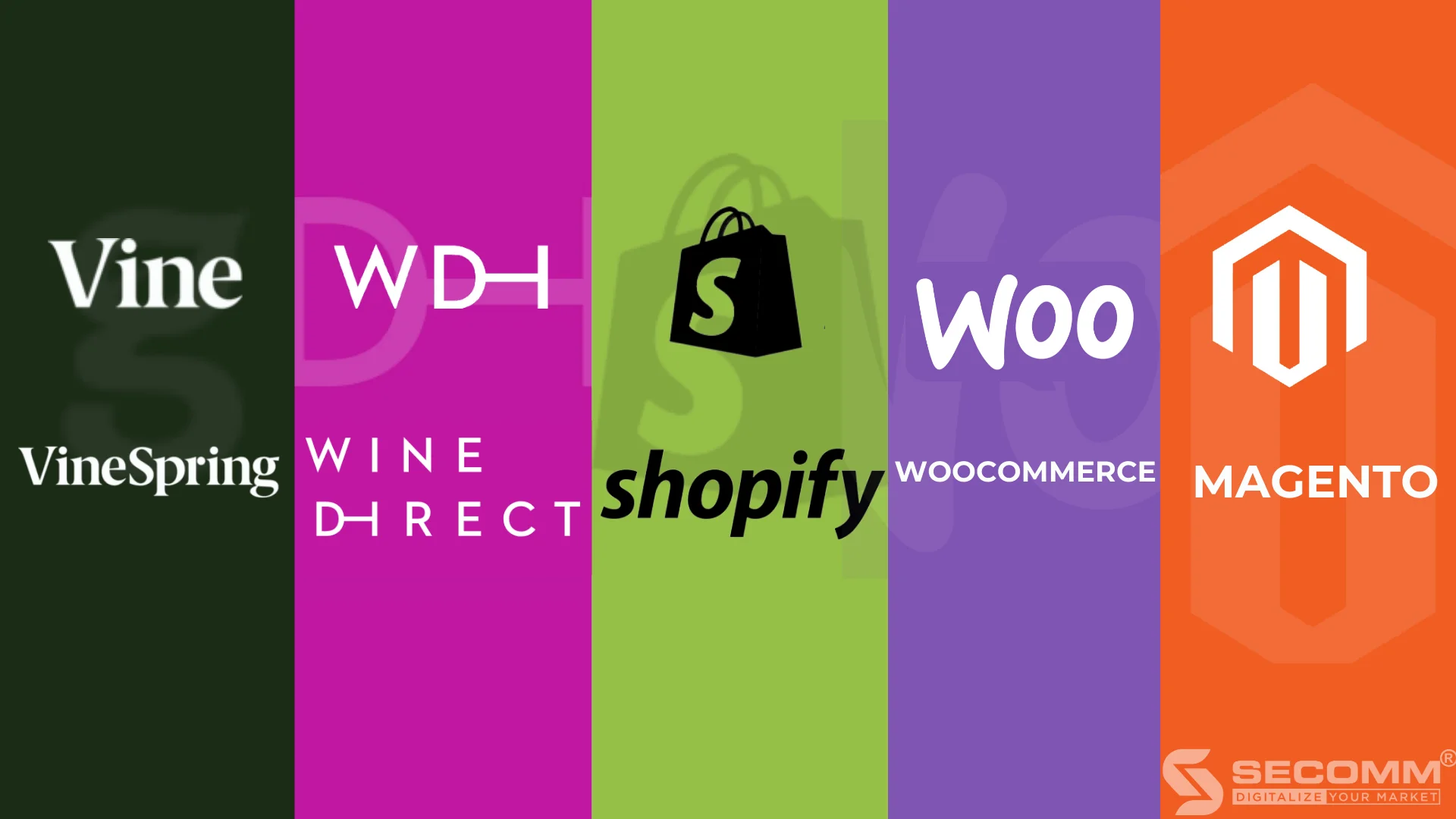
5 ECOMMERCE PLATFORMS FOR THE WINE INDUSTRY BUSINESSES
The electronic commerce market in the liquor industry is currently experiencing robust development and has become a dominant trend in many different countries. In 2021 alone, the number of alcohol consumers increased by 10–20%, and those following the trend saw a growth of 40–50%, indicating significant progress in eCommerce for the alcohol industry in recent times (according to Wine Intelligent).
Not only limited to user growth, the global eCommerce market for wine is expected to grow by 7.7% annually (according to Statista) and reach a value of 1.68 trillion by 2025 (according to Cision). This presents both an opportunity and a challenge for liquor businesses to grasp and develop a business model suitable for the changing market in the digital era.
To embark on an online liquor business, the selection of an eCommerce platform needs careful consideration and precise decision-making. Choosing the right platform aligned with the budget and objectives helps businesses save time in construction, utilise human resources efficiently, and save costs in building and developing the system. Simultaneously, it assists businesses in reaching a large customer base, boosting sales, and seizing sustainable development opportunities in the future.
Currently, there are primarily two types of eCommerce platforms on the market: open-source and service-based. Each type of platform has certain advantages and disadvantages, and businesses need to carefully weigh criteria that align with their business model to choose a suitable platform.
Criteria for Choosing an eCommerce Platform in the Liquor Industry
Suitable Interface for the eCommerce System in the Liquor Industry
Wine products belong to the premium segment in modern life. Therefore, customers always prioritize high-quality visuals, and eye-catching, user-friendly interfaces in the eCommerce system that are easy to use and navigate.
Businesses in the liquor industry need to focus on conveying the product’s value message not only through a well-designed and user-friendly interface but also one that has high aesthetic appeal, with distinctive features to communicate the brand and product values to the specific target customers of the industry. This approach ensures a comprehensive user experience when using the eCommerce system.
Diverse eCommerce Feature System, from Basic to Advanced to Specialized
eCommerce platforms should have a diverse range of features, from basic to advanced, and even specialized features tailored for the liquor industry. This facilitates the efficient and sustainable development of the eCommerce system for businesses. Basic features include management, storefronts, sales, information management, statistics, revenue control, customer lists, invoices, shopping carts, and checkout, as well as reporting and analysis.
Advanced features related to themes, products, marketing, optimized payment solutions, discounts, and shipping cater to the operational and developmental needs of sustainable eCommerce for businesses. Specialized features for the liquor industry may include product allocation, inventory control, membership management (Wine club memberships management), implementing customer loyalty programmes, and product-specific discounts based on business needs.
Read more: SaaS eCommerce platforms vs Open-Source eCommerce platforms
High Integration Capability
For a seamless online business system in the liquor industry, businesses often integrate eCommerce platforms with other software and technology platforms they currently use, such as payment systems, shipping, ERP, POS, CRM, marketing management, etc.
This requires the eCommerce platform to have flexible, seamless, and effective integration capabilities with this software without compromising the execution of each system. This integration not only helps businesses overcome manual operational limitations but also increases automation for both back-office management and sales processes, ensuring high accuracy and operational efficiency for the business’s development.
Payment and Delivery Software
In addition to supporting Cash On Delivery (COD), platforms need to integrate various payment software, including local and international card options, payment gateways (Paypal, Stripe, One Pay, etc.), and digital wallets (Momo, ZaloPay, etc.). The chosen eCommerce platform should have the ability to seamlessly integrate this payment software with high security, safety, and efficiency.
For delivery and logistics, businesses can integrate service providers and popular transportation tracking applications, optimizing and streamlining delivery processes. Businesses can customize and develop delivery modes suitable for customers, ensuring a comfortable and convenient buying and receiving experience for users. Integrating payment and delivery software helps shorten the purchasing journey, optimize the user experience, and prompt customers to make decisions quickly.
Enterprise Resource Planning (ERP), Customer Relationship Management (CRM) Software
Businesses can fully integrate third-party enterprise management software such as ERP, CRM, POS, etc., with the eCommerce system to support efficient and seamless multi-channel eCommerce operations. This synchronizes data on products, categories, orders, and user information across systems, simplifying and automating the back-office management and sales processes, ensuring high accuracy and operational efficiency for sustainable development.
Marketing Management Software
In addition to the marketing tools available on the eCommerce platform, businesses can integrate additional marketing tools such as email marketing software (MailChimp, Drip, etc.), marketing analysis software (Google Analytics, Google Adwords Keywords, etc.), and social media management software (Buffer, Hootsuite, etc.). Marketing management software helps businesses deploy marketing campaigns, attract customers, and increase conversion rates, maximizing both eCommerce and overall business revenue.
Maximum Scalability
Choosing an eCommerce platform in the liquor industry with high scalability is crucial for businesses to grow sustainably. The platform should seamlessly accompany the business through various business models, from entering eCommerce for the first time to expanding the business system. It should support diverse business models such as B2B, B2C, D2C, and B2B2C.
Furthermore, the platform should assist businesses in operating and expanding by supporting the management of multiple websites, catering to multiple countries, and handling various currencies, all within a unified system. Beyond that, platforms with high scalability not only support expansion but also ensure stable system operation even when the website experiences gradual increases in traffic over time or experiences sudden spikes in traffic during promotional campaigns.
Top 5 Specialized eCommerce Platforms in the Wine Industry
VineSpring
VineSpring is an eCommerce platform created by experts with in-depth knowledge of the wine industry’s operations. As a result, businesses will have an online eCommerce system with specialized features for the wine industry.

Evaluation based on criteria
Interface Criteria
- Industry-specific Interface Design:
VineSpring offers a rich interface library, collaborating with various unique website designers specifically for the online wine industry. This allows businesses to easily build their brand without needing extensive technological knowledge.
- Multimedia Experience:
Understanding the present needs of businesses, VineSpring has developed and optimized its platform to operate flexibly on various media, from desktops and tablets to personal mobile devices. This ensures businesses have a multimedia online presence and provides the best shopping experience.
- Prominent CMS System:
With a CMS system on the VineSpring platform, businesses can fine-tune content and essential product information, brand details, and success stories tailored to their business development needs. This enables businesses to have a highly interactive website and a friendlier user experience.
Integration Capability Criteria
- Shipping Software Integration:
The platform also supports businesses in terms of product shipping. VineSpring can integrate additional shipping software (ShipCompliant and ShipStation), assisting businesses in controlling information and making order tracking easy for customers on the website.
- Management Software Integration:
VineSpring directly integrates with Square POS software through an available technical team. The VineSpring POS system has a “tap, chip, and swipe” feature, enabling businesses to process orders quickly and conveniently. Additionally, VineSpring can integrate CRM software (Salesforce) to provide efficient solutions for management, sales, and customer care.
- Marketing Management Software Integration:
VineSpring supports businesses in marketing through the integration of email marketing software (Mailchimp) for list management and the creation of email marketing campaigns, increasing automation in operations.
eCommerce Feature System Criteria
- Basic and Advanced Features:
Vinspring has a system of basic and some advanced features sufficient for businesses to operate at a basic level. Especially, Vinespring has optimized inventory management features to save time, allowing businesses to access production history details, including information on bottling times, prices, and shipping units.
- Specialized Features:
Vinespring is an ideal solution for developing a business’s recurring revenue model in the eCommerce wine industry. The platform provides businesses with specialized features, such as wine allocation management and wine club member management.
In addition to the mentioned advantages, Vinespring also has a dedicated customer care team. As a Software as a Service (SaaS) eCommerce platform, VineSpring places a strong emphasis on customer service through 24/7 online chat with experts and telephone support anywhere, anytime. Therefore, businesses will receive the best and fastest support to resolve technical issues, as well as applications, features, and the most convenient and suitable solutions.
Cost
VineSpring is a Software as a Service (SaaS) platform, so businesses need to pay a fixed monthly fee ranging from $99 to $399, depending on the service package, and may be higher based on business needs:
- VineSpring Starter – $99/month: Provides businesses with a store system that includes hosting, payment software from VineSpring, and free direct support.
- VineSpring Standard – $199/month: Businesses have control over inventory, allocation management, custom store interface plugins, and integration with the ShipCompliant shipping feature.
- VineSpring Professional – $399/month: Businesses receive all essential features from the VineSpring Standard package, along with integration with Square POS software and the MailChimp marketing tool.
- VineSpring Enterprise: Ideal for large-scale wine businesses with high sales volume. The price for this package varies depending on the scale of the business.
User Target
The VineSpring platform (SaaS) is suitable for wine businesses with limited experience in building eCommerce systems. However, the usage fees for this platform are relatively high for small and medium-sized businesses.
WineDirect
WineDirect is a Software as a Service (SaaS) platform designed for wine businesses with no experience in eCommerce platforms, helping manage every aspect of online sales and simplifying the business process.
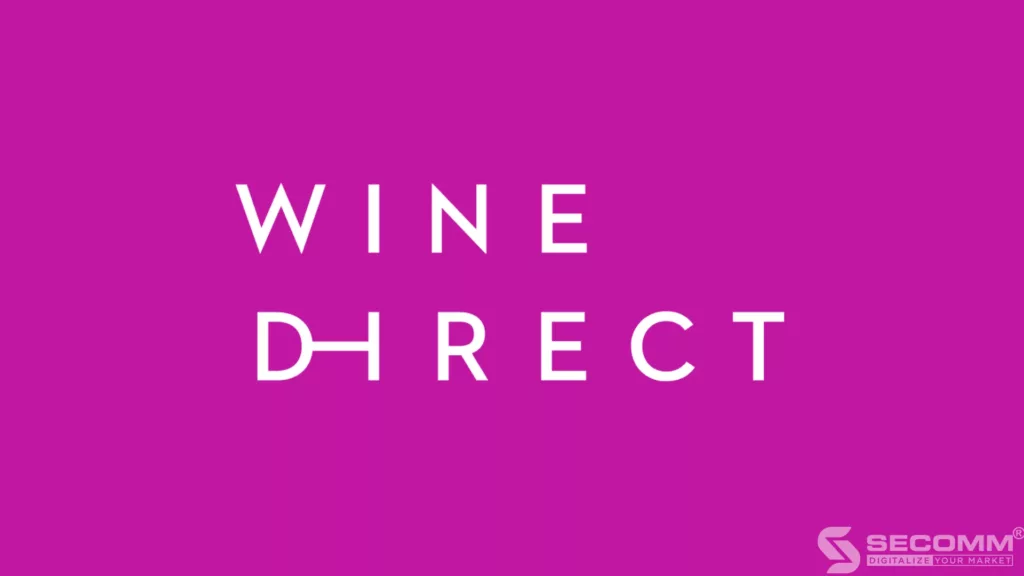
Evaluation based on criteria
Criteria for Interface
The WineDirect platform provides an intuitive, user-friendly interface tailored for businesses. Additionally, WineDirect offers a diverse range of free interface templates and features, facilitating easy development of the eCommerce system with just basic website development knowledge and skills.
Criteria for eCommerce System Features
- Basic Features:
WineDirect provides fundamental features such as website analytics, sales tools, and options for business event registrations to boost customer engagement. This allows businesses to save time and unnecessary costs associated with other software.
- Advanced Features:
Businesses can possess essential information for creating customized offers and discounts tailored to each customer category, based on statistics gathered through integrated tools. Consequently, businesses can develop personalized shopping experiences and drive higher sales volumes, achieving outstanding results and meeting development needs.
- Special Features:
The platform has leveraged and optimized the WineDirect application, specially designed for mobile devices and is highly flexible for the wine industry. Through the application, businesses can manage products, eCommerce systems, advertising campaigns on the website, and customer information.
Integration Criteria
- Payment and Shipping Integration:
WineDirect provides integrated payment solutions on the platform, enabling businesses to have a seamless experience across two payment software, such as WineDirect Payments for businesses in the US and Canada, and eWay Payments for businesses in Australia.
With payment software, businesses are supported in processing orders through the website or in-store. Regarding shipping, the WineDirect platform can integrate with various shipping services (UPS, FedEx, Gliding Eagle, etc.), assisting businesses with detailed shipping information for each order and enhancing automation in the shipping process.
- Management Software Integration:
The WineDirect platform can integrate with ERP software, as well as the POS of the business (WineDirect POS, Napa Valley, Oztera, etc.), aiming to synchronize data between the POS system and the eCommerce system, including orders, inventory, wine club members, customer information, helping businesses increase automation in the operational process and manage information effectively.
- Marketing Tool Integration:
WineDirect has integrated available marketing tools on the platform to help businesses save time in system development. This includes providing businesses with access to real-time sales reports, allowing them to send emails based on customer groups depending on marketing campaigns.
Cost
The WineDirect platform is a SaaS (Software as a Service) eCommerce platform with three main pricing plans as follows:
- DTC Starter – $79 + 2% of monthly sales: Businesses integrate marketing tools, payment software, and Ship Compliant shipping, with free hosting included.
- DTC Pro starting from $199 + 1% of monthly sales: Businesses receive all the essential features from the DTC Starter package, as well as customer loyalty programs, reports, and automatic credit card updates.
- DTC Advanced: Businesses get all the features from the DTC Pro package, along with custom benefits to fit the scale and needs of the business. The usage cost for this service package varies based on the business’s requirements and scale.
User Target
Similar to VineSpring, the WineDirect platform (SaaS) is suitable for businesses of various models and sizes that lack extensive experience in building eCommerce systems and technology. However, one platform limitation is its high usage cost, which increases with the business’s monthly sales volume.
Beyond the high usage cost, operational tools on the platform may be unstable, occasionally displaying errors on the system, such as payment statuses showing as ‘pending processing’ on the business side but appearing as ‘paid’ on the customer side. Despite this, WineDirect has a dedicated customer support team that efficiently addresses business issues, making it a preferred choice for many businesses.
Shopify
Shopify is a well-known giant in the field of building eCommerce systems as a Software as a Service (SaaS). The Shopify platform is favoured in the market for its user-friendly nature, quick system-building time, and low initial costs, making it suitable for a wide range of businesses.
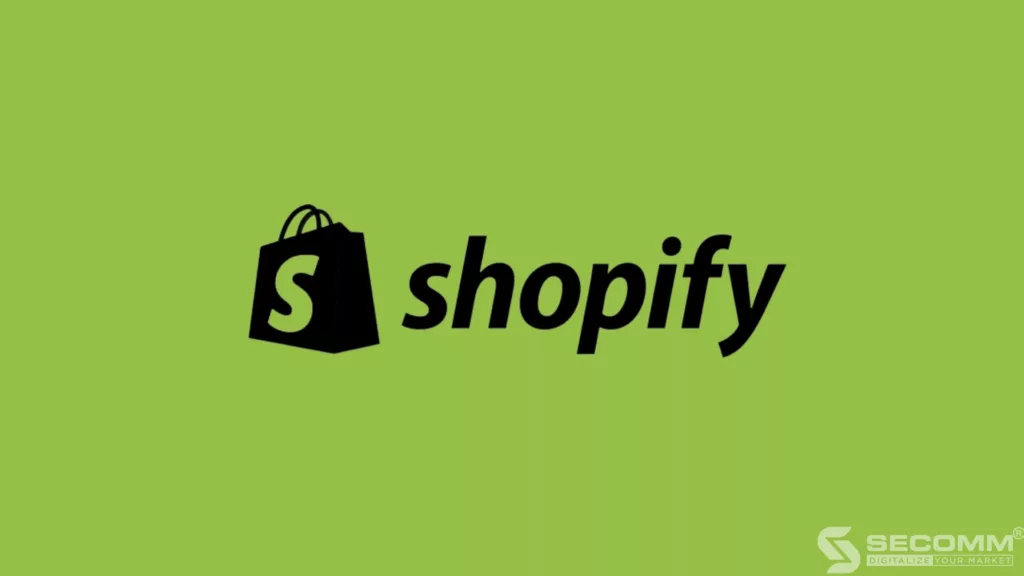
Evaluation based on criteria
Criteria for Interface
In terms of interface, Shopify provides many beautiful themes that are well-compatible across various devices. Businesses in the wine industry can choose from several specialized templates designed and offered specifically for online wine businesses by the Shopify platform. Additionally, businesses have the freedom to customize the interface by accessing HTML and CSS code to enhance the brand’s uniqueness. Therefore, businesses can deliver a seamless experience across different devices without affecting the user’s shopping process.
Criteria for eCommerce System Features
Basic and Advanced Features:
In addition to basic features related to orders, products, categories, and product management, the Shopify eCommerce platform allows businesses in the wine industry to access profiles and purchase histories to gather customer information. This enables businesses to personalize the shopping experience, from personalized content and product displays to the entire eCommerce journey.
This key aspect helps businesses make a positive impression on consumers and fosters a stronger relationship between both parties. Furthermore, with the mobile application developed by Shopify, businesses can control every aspect of the online store anytime, anywhere, including effective sales management, order fulfilment, and inventory management.
Integration Criteria
- Integration of Payment and Shipping Software:
In addition to supporting direct payment features from the platform itself (Shopify Payment), Shopify also assists businesses in integrating other payment software such as Paypal, Stripe, SagePay, AliPay Global, etc. Regarding shipping software, Shopify collaborates directly with various major shipping service providers like USPS, UPS, and DHL to streamline the process and ensure more convenient shipping for businesses.
- Integration of Enterprise Resource Planning (ERP) Software:
Shopify’s Global ERP Program provides businesses with a system that connects multiple eCommerce platforms with critical business databases such as finance and inventory to optimize operations and business processes. This program includes partnerships with leading global ERP providers such as Microsoft Dynamics 365, Business Central, Oracle NetSuite, Infor, Acumatica, and Brightpearl.
- Automatic Integration of Marketing Tools:
Shopify supports businesses in marketing through integrated software within the system. Examples include email software (MailChimp), sales channels (Facebook, Instagram), advertising (Google Ads), etc. Through these integrated marketing tools, businesses have the opportunity to increase sales, automate email marketing, and develop marketing campaigns tailored to specific customer groups.
Cost
Shopify has developed various service plans suitable for businesses to choose from based on their capabilities and scale:
- Basic Shopify – $29/month: Suitable for new businesses with modest sales volume.
- Shopify – $79/month: Suitable for growing online businesses experiencing increased sales.
- Advanced Shopify – $299/month: Suitable for businesses with the need to expand scale and require advanced reporting and analytics tools.
In addition, Shopify has introduced other service plans to cater to diverse business needs:
- Shopify Lite – $9/month: Suitable for businesses wanting to add a buy button and payment services to an existing website or blog.
- Shopify Plus – $2000/month: Provides an advanced eCommerce solution for large enterprises handling a substantial volume of orders.
User Target
Originally an industry giant in the Software as a Service (SaaS) eCommerce sector with characteristics of rapid system development time, as well as a startup cost suitable for many businesses and easy usability, this platform is suitable for small and medium-sized enterprises with limited experience in information technology.
However, in addition to the monthly fees for using additional utilities, Shopify also has limitations in terms of advanced features, unique features, and customization. Businesses must accept that certain features may not be available on the current website and may need to switch platforms when aiming to build a specialized system that aligns with their specific needs and ensures sustainable development in the future.
Read more:
- What is Shopify Plus? The pros and cons of Shopify Plus
- Shopify vs Shopify Plus 2023: Which is a better choice?
WooCommerce
WooCommerce is an open-source Content Management System (CMS) known as a plugin for WordPress, introduced in 2011. It is completely free and allows businesses to turn their WordPress website into an online store. Therefore, in addition to being suitable for customizing the interface, WooCommerce is also an ideal platform for businesses to have a website with a flexible blog section, high interactivity, and a more user-friendly experience.
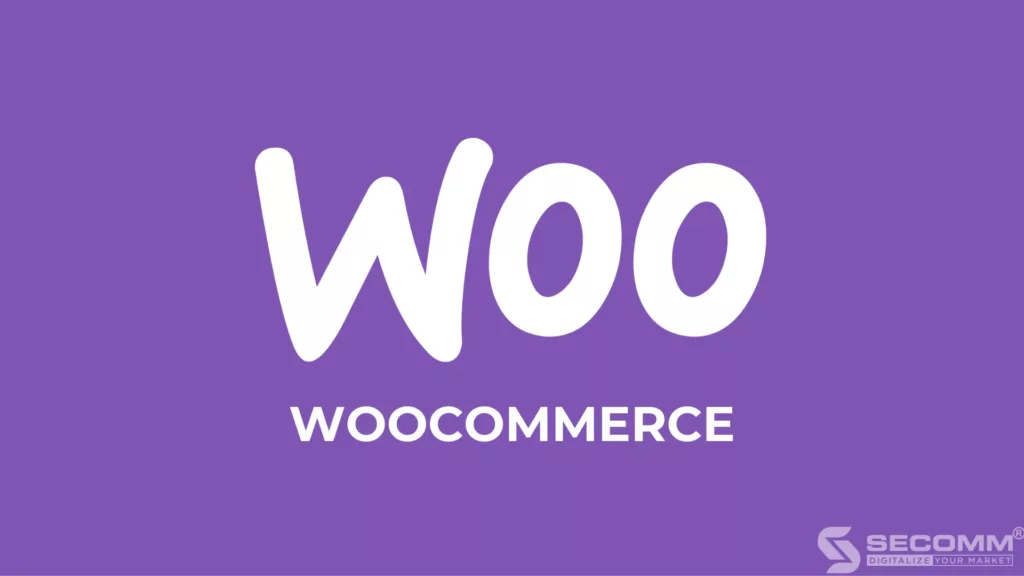
Evaluation based on criteria
Criteria for Interface
- The rich and customizable form library:
WooCommerce possesses and provides businesses with a rich library of forms designed for the wine industry, carefully crafted and user-friendly. Therefore, businesses can conveniently design and build an eCommerce system right from the beginning without needing in-depth technical knowledge
- User-friendly interface with Product Table:
With the WooCommerce platform, businesses can integrate tools from management systems to features specific to the wine industry. For instance, the platform can integrate with Product Table, a tool that allows wine businesses to have an interface displaying product attributes and numerous high-quality product images, as well as filtering features.
Criteria for eCommerce System Features
WooCommerce allows and supports basic features such as inventory management, order processing, inventory optimization, SEO tools, discounts, price reductions, sales statistics reports, and easy integration with payment and shipping providers. In terms of advanced features, the WooCommerce platform supports businesses in the wine industry with opportunities for wholesale orders and discounts, boosting sales through the eCommerce system. However, the platform has some limitations in terms of specialized features for the wine industry, as making certain edits can potentially cause instability in the system.
Integration Criteria
- Payment and Shipping Software:
For payments, businesses can use plugins to integrate payment gateways such as Stripe, PayPal, Apple Pay, and Square into the system, ensuring high security and safety.
Regarding shipping, businesses can integrate with various shipping providers that collaborate with WooCommerce, such as FedEx, UPS, and USPS, enabling efficient processing and optimization of the shipping process to provide the best shopping experience for consumers.
- Business Management Software:
The WooCommerce platform allows and supports businesses with integrable business management software, typical examples being Odoo, Square POS, and WP ERP. This enables businesses to save time, and costs, improve business efficiency, and automate management processes.
- Marketing Management Software:
Businesses can integrate marketing management software to support their operations, such as email marketing (MailChimp), advertising (Google Listings, Google Ads, Facebook), and analytics software (Google Analytics). This helps businesses increase traffic, promote repeat shopping, and optimize personalization for consumers.
Cost
The WooCommerce platform is an open-source platform, and thus, the platform itself is entirely free to use. However, businesses may incur development costs when utilizing the platform, such as domain registration fees ($15), hosting fees ($120/year), and system development costs (ranging from $3,000 to $10,000 depending on the complexity of the system).
User Target
WooCommerce is a suitable platform for wine businesses already familiar with WordPress and looking to expand their eCommerce systems, offering numerous basic features built with high availability from developers in the strong global community. However, WooCommerce is not perfect for businesses with a large number of products, as the system tends to be unstable with more than 2,000 SKUs.
The platform also has limitations in terms of customization and fine-tuning specific features because intervening adjustments can easily lead to system instability, and there is a high likelihood that the built-in features are not compatible with this platform. Additionally, to customize the system based on the available feature set, businesses may encounter significant difficulties and time-consuming efforts.
Magento – The best all-around platform for the wine industry
Magento is an open-source eCommerce platform known as one of the leading eCommerce platforms today, with many outstanding advantages such as high flexibility, a diverse ecosystem, and optimal security. Currently, Magento has two versions: Magento Open Source (free) and Magento Commerce (paid).
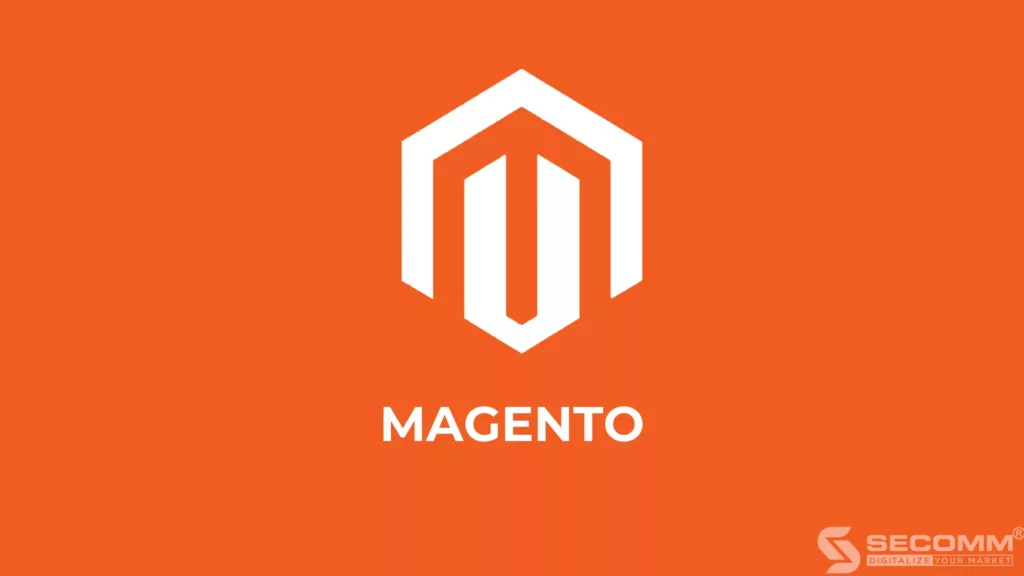
Evaluation based on criteria
Criteria for Interface
With the Magento open-source eCommerce platform, businesses may not have access to an extensive theme library as other eCommerce platforms do. However, businesses can fully customize the interface for a specialized eCommerce system, providing a comfortable user experience. To achieve this, businesses need an experienced technical team and careful investment.
Criteria for eCommerce System Features
The Magento eCommerce platform offers a highly diverse and advanced feature system, from basic to advanced, making it easy for wine industry businesses to quickly build and develop their systems in the short term and sustainably in the long term.
- Basic features:
A variety of features ranging from Category Management, Content Management, Customer Management, Marketing Management, Order Management, Store Management, System Management, Cart and Checkout, to Reporting & Analytics.
- Advanced features:
Magento is known for its superiorly developed advanced features and extensions to meet the rapid development of the eCommerce market and the specialized requirements of each business. Thousands of advanced functions related to themes, products, marketing, optimal payment solutions, shipping, etc., have been built with flexibility and high availability, delivering outstanding results when integrated into the system, and meeting every operational and sustainable eCommerce development need of businesses.
- Specialized features:
Businesses can completely modify system functions, develop new specialized features to meet business needs, and quickly adapt to market changes. In addition, businesses can comfortably expand the scale of their business with the open-source Magento platform.
Integration Criteria
- Payment and Shipping Software:
Regarding payments, wine industry businesses using the Magento eCommerce platform can integrate the most common payment methods such as card payments (ATM, Visa, Master…), e-wallets (Momo, Zalo Pay…), and payment gateways (OnePay, VNPay, PayPal, etc.), helping diversify the shopping payment experience.
For shipping, businesses can easily integrate with various shipping providers and popular shipment tracking applications on the market to optimize shipping and delivery processes. Additionally, wine industry businesses can develop shipping and delivery features tailored to their needs and customers to provide a convenient and fast delivery experience.
- Business Management Software:
Magento is praised for its highly effective operation with most POS (Square…), CRM (Salesforce…), and ERP (SAP, Oracle, Odoo) systems. Through efficient integration of these software solutions, businesses can overcome manual operation limitations and increase automation for both back-office management and sales, ensuring high accuracy and operational efficiency for sustainable development.
- Marketing Management Software:
For marketing management software, businesses can integrate various management software solutions, including email marketing (Mailchimp…), and advertising (Facebook, Google…), to support planning marketing programs, strategy setting, as well as handling and controlling data, seamless eCommerce business processes, and optimizing online business.
Additionally, Magento provides Magento BI tools or allows businesses to integrate with other Business Intelligence (BI) tools such as Power BI, Tableau, Looker, etc., to optimize business efficiency, easily consolidate and leverage data from the Magento system and other software for quick, efficient analysis and reporting, and to improve business strategy and growth optimization for the enterprise.
Criteria for scalability
Inheriting the high scalability of the open-source platform, Magento can accompany businesses with every sustainable development business model, from newly established enterprises to expanded business systems, covering various business models such as B2B, B2C, D2C, and B2B2C.
Magento can support businesses to operate and expand into multiple websites, countries, and multiple currencies, and manage all within one system. Not only that, Magento also supports stable system operation even when the website experiences gradual or sudden increases in traffic over time or during peak periods in promotional campaigns, with the ability to handle up to 500,000 products and thousands of transactions per hour.
Cost
Magento is an ideal platform for any business venturing into the wine industry and implementing eCommerce. However, the cost issue is a significant obstacle, preventing most small and medium-sized wine businesses from choosing the Magento platform to build an eCommerce system.
According to estimates, a fully functional system developed on the Magento eCommerce platform typically incurs deployment and development costs ranging from $10,000 to $100,000 or more. In addition to the complex and advanced feature set, a crucial factor contributing to the higher deployment costs of Magento compared to other platforms is the requirement for an experienced and specialized team.
User Target
Magento is often the platform of choice for large businesses in the wine industry, whether B2B, B2C, or D2C, that already have an existing customer base and a long-term need for developing an eCommerce system. With this platform, businesses can continually develop components within the eCommerce system to ensure optimal operational efficiency and sustainable growth.
The high development costs, as well as the development timeline, which can range from 2-3 months to sometimes up to a year, are barriers that make it challenging for small and medium-sized businesses to comfortably choose Magento.
Choosing an eCommerce Platform for the Wine Industry
Choosing the right eCommerce platform is crucial in building an eCommerce system for businesses in the wine industry. This decision not only minimizes investment costs and shortens the time to build an eCommerce system but also helps businesses gain a competitive advantage in the industry and achieve sustainable growth.
On the other hand, an inappropriate platform choice can lead to significant time and cost investments for migration and platform conversion. Therefore, businesses need to consider their goals, and issues in the current model to choose the most suitable platform.
For small and medium-sized businesses, newcomers to the eCommerce market, or large businesses without the need to build a specialized eCommerce system, they can choose Software as a Service (SaaS) eCommerce platforms such as VineSpring, Winedirect, Shopify, or the open-source platform WooCommerce.
If businesses focus on industry-specific features such as developing a subscription revenue model and managing wine clubs, VineSpring and Wine Direct are suitable choices. WooCommerce is convenient for businesses that emphasize adjusting the interface. Shopify is suitable for businesses that want to quickly develop an eCommerce website with low initial costs.
For large businesses or those wanting to build a specialized eCommerce system tailored to the characteristics of their products, business model, or a platform that can accompany the sustainable development of the business, choosing comprehensive open-source platforms like Magento is necessary. With open-source platforms like Magento, businesses can develop special features, design interfaces freely, and not worry too much about the operating system.
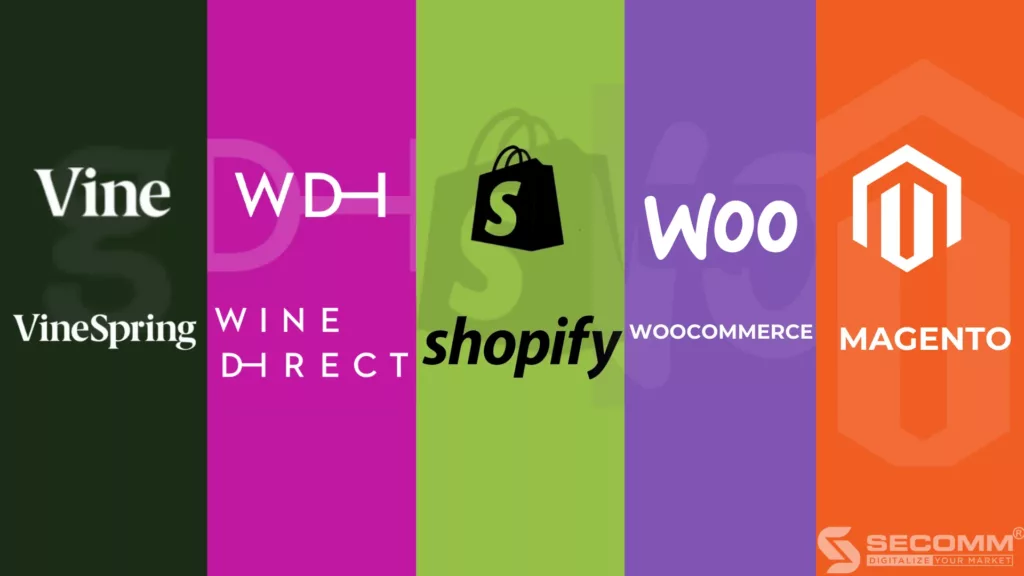
SECOMM confidently accompanies wine businesses on the path of deploying and developing sustainable eCommerce, with successful implementation experience for many wine businesses in various countries such as Singapore, the United States, Australia, Japan, and Vietnam.
Contact SECOMM for detailed advice on the development journey of the eCommerce system for your wine business!
 2
2

 7,043
7,043

 0
0

 1
1
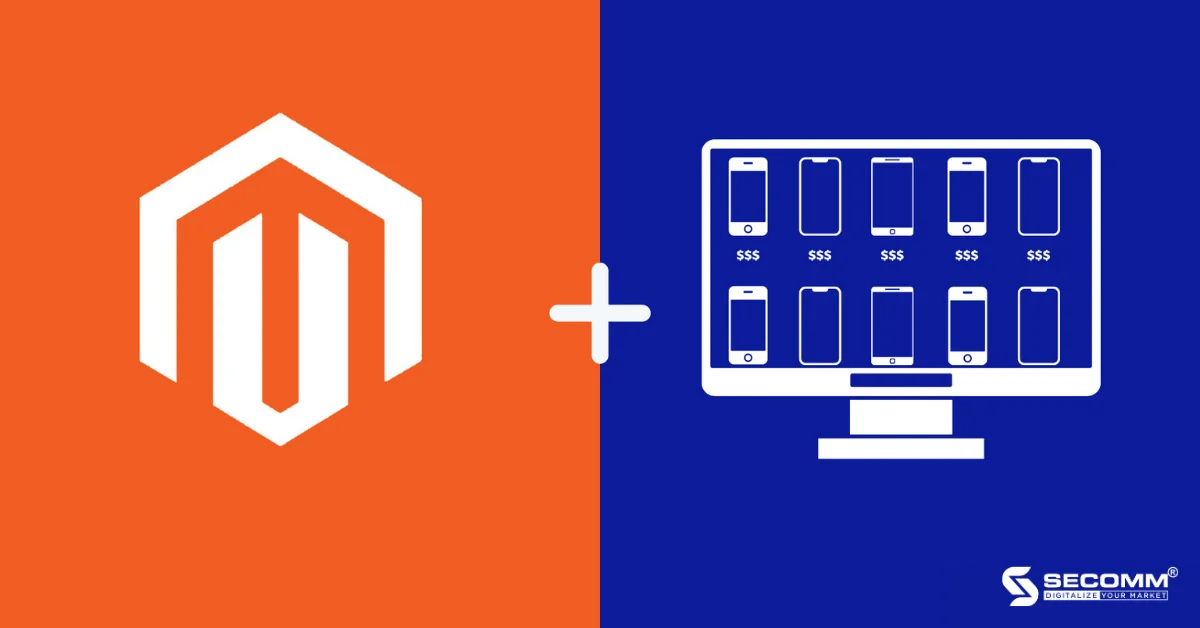
ECOMMERCE WEBSITE FOR MOBILE RETAIL WITH MAGENTO
In 2022, the mobile phone retail market is predicted to reach sales figures of up to 1.39 billion units, marking a 3.8% annual increase (according to Trendforce). The Covid pandemic has significantly altered consumer interactions and shopping habits, shifting the purchase of mobile phones from offline to online. Traditional retailers have now caught up with this trend by embracing eCommerce to enhance their competitive edge and sustain growth regardless of the pandemic.
To enter the eCommerce market and seize competitive opportunities, businesses need to identify a suitable eCommerce platform aligned with their business objectives. Apart from popular names like Shopify, BigCommerce, Haravan, and WooCommerce, Magento is recognized as a platform chosen by major players in the mobile phone retail industry in Vietnam, such as CellphoneS, Phong Vũ, and Bạch Long Mobile. So, why is Magento the preferred choice for these businesses?
Advantages of Building a Mobile Phone Retail Website with Magento
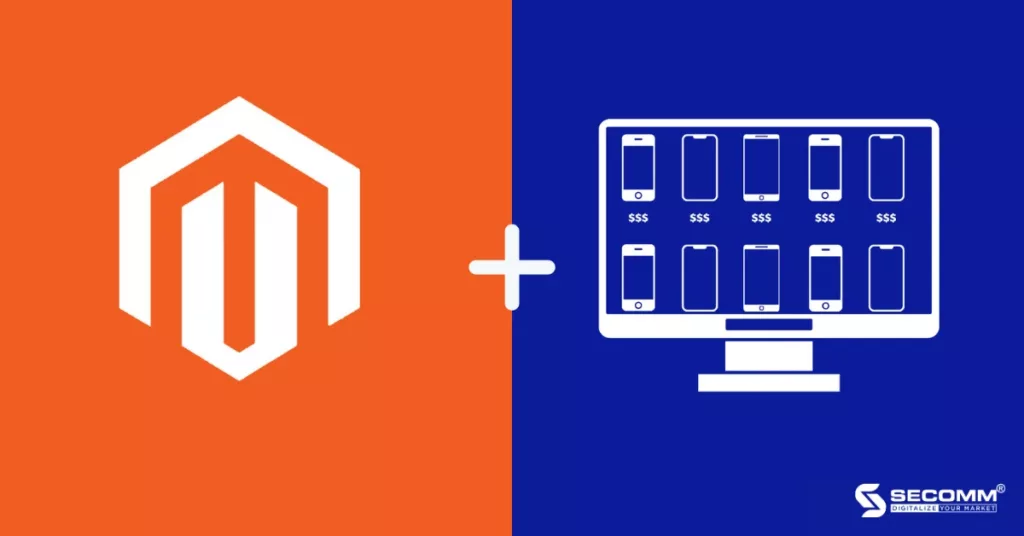
Advantages of Building a Mobile Phone Retail Website with Magento
eCommerce Feature System from Basic to Advanced
Basic Features
As a specialized eCommerce platform, Magento naturally offers a full range of basic features such as category management, content management, sales, customer management, marketing, inventory management, as well as reports and analysis. These features allow businesses to easily embark on their eCommerce journey in a short period.
Magento also possesses an ecosystem with many features supporting the development of in-depth mobile phone business systems.
- Category Management: Manage, develop, and control all data and functions related to products, attributes (brand, price, type of phone, performance, memory, special features, design, screen, size, etc.), pricing system, inventory, images, and videos to maintain efficient business operations.
- Content Management: Develop and refine necessary content and detailed information about products, such as place of origin, brand, instructional videos, and product reviews.
- Marketing Management: Deploy and manage various marketing campaigns according to seasons (Tet, Black Friday, Cyber Monday, Christmas, Flash Sale), and special occasions (launch of new products by Samsung, Apple, Oppo, etc.). These marketing campaigns need to be continuously updated as the product lifecycle shortens, and mobile phone products are constantly innovated.
- Sales Management: Easily set up and operate proactive sales processes through various methods such as barcode sales, item code sales, and brand-based sales (iPhone, Samsung, etc.). Businesses can also integrate customer management to ensure timely warranty service for purchased products.
- Customer Management: Manage comprehensive information about customers to improve marketing efficiency, enhance the shopping experience, and elevate customer satisfaction. This information helps create suitable customer care policies, such as value-added order discounts and gift appreciation for loyal customers, turning ordinary customers into loyal ones.
- Inventory Management: Proactively control the number of phones in each warehouse (by product group, brand, item code, and country of origin), making it easy to supply accurate and fast goods.
- System Management: Administers administrative privileges, uses tools for regular management, and maintenance, and supports the system to operate stably and efficiently.
- Reporting & Analytics: Effectively analyze data after marketing campaigns or accumulate sales data day by day through comprehensive and detailed reporting features to improve and enhance business efficiency. Includes Marketing Reports, Sales Reports, Customer Reports, Product Reports, Review Reports, and Performance Reports.
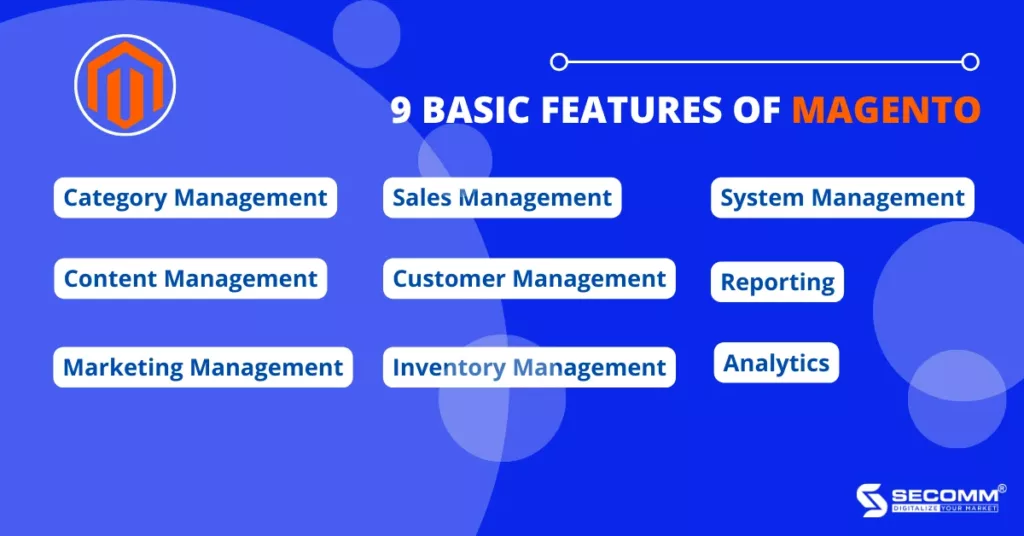
Advanced Features
The Magento platform is known for its advanced features and extensive extensions developed to meet the rapid development of the eCommerce market and the specific requirements of each business. Thousands of advanced functions related to themes, add-ons, products, marketing, payment, shipping, etc., have been built with flexibility and high availability, delivering outstanding results when integrated into systems, meeting every operational need, and supporting the sustainable development of eCommerce for businesses.
Some advanced features for mobile phone retail that Magento supports include:
Flash Sale Feature: a discount mechanism for certain items or products within a specified time. The strategy of appealing to the customer’s psychology of “buy quickly, get a good price” is being effectively applied by many major mobile phone retailers. With Magento, businesses can easily create multiple Flash sales with countdown timers.

Buy Now Pay Later Feature: This is a popular payment method in the international online mobile phone retail industry but is relatively new in the Vietnamese market. After completing the order, customers will receive the product immediately, and the payment will be gradually made over a certain period with low or 0% interest. Breaking down the payment into instalments will reduce financial pressure on users when buying high-value products such as mobile phones, boosting the number of orders and revenue for businesses.
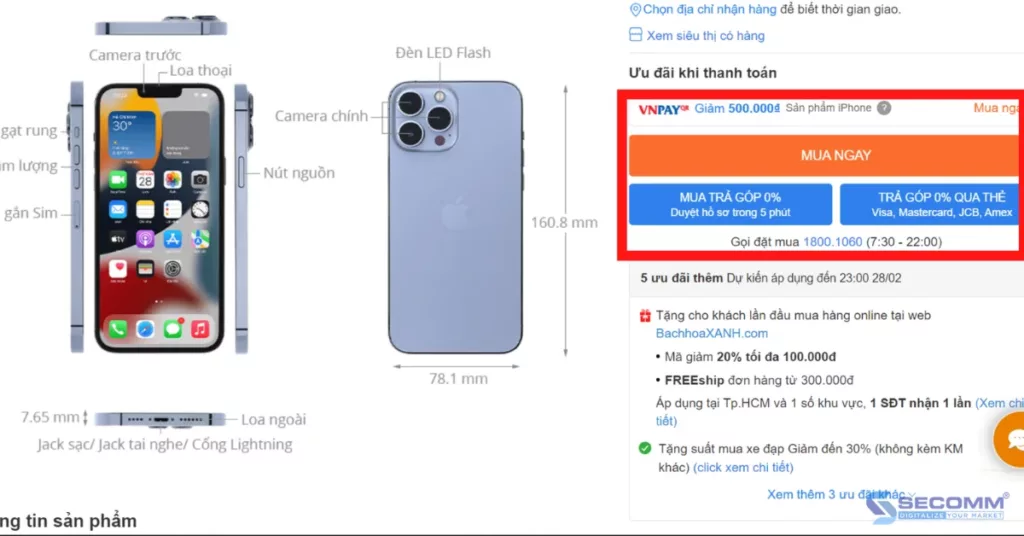
Advanced SEO Feature: In addition to supporting keywords, meta tags, descriptions, product titles, and searching for appropriate URLs, the Magento platform also updates ranking factors, provides URL structures, and offers meta deployment options to enhance SEO for eCommerce websites, increasing traffic and competitiveness in the market.
Flexibility in Interface Design
Mobile eCommerce is one of the industries that require an eCommerce website to have a sleek, standardized UI/UX interface with high aesthetics to convey brand and product values, attracting customers to shop within the system. Although Magento does not possess an extensive theme repository like some other platforms, each theme on the platform is meticulously and uniquely designed.
Businesses can choose to use these themes in the initial stages to save costs. To further refine the interface to better align with the brand’s positioning, businesses can customize based on the chosen theme or design a unique interface. However, this process will require more investment in terms of cost and time.
High Scalability
Magento supports stable system operation even when the website experiences a gradual increase in traffic over time or a sudden surge during business campaigns, with the capability to handle up to 500,000 products and thousands of transactions within an hour.
Furthermore, Magento also supports business expansion into multiple websites for various countries, all manageable on the same “dashboard.” This means that businesses can access and manage data for multiple websites/stores simultaneously using a centralized Magento system. With built-in language conversion support, businesses can build an eCommerce system with content and language tailored to diverse global customer demographics.
Moreover, the Magento system allows for easy conversion of currencies, supporting businesses in expanding their market presence across multiple countries and providing customers with a seamless transaction experience for optimal shopping.
Easy Integration Capability
Diverse Payment and Delivery Integration
In the eCommerce industry, especially in online mobile retail, having a variety of secure and flexible payment methods is crucial. Common payment methods include card payments (ATM, Visa, Mastercard), e-wallets (Momo, Zalo Pay), payment gateways (OnePay, VNPay, PayPal), cash on delivery (COD), etc. For delivery, Magento seamlessly integrates with various delivery services available both internationally and in Vietnam, such as FedEx, DHL, Giao Hàng Nhanh, Giao Hàng Tiết Kiệm, Viettel Post, along with popular shipment tracking applications. This ensures efficient handling and optimization of delivery processes. Furthermore, businesses can develop and customize new delivery features to align with customer preferences.
Integration with Enterprise Management Systems
Aside from stable system operation during online business, efficiently managing products and orders is a crucial consideration for businesses. Integrating the website with enterprise management systems (ERP, CRM, etc.) minimizes manual operations and automates operational processes, ensuring high accuracy and operational efficiency for business development. Magento is highly compatible with various management software, such as POS (Square), CRM (Salesforce), and ERP (SAP, Oracle, Odoo), making it a preferred choice for many businesses.
Integration with Marketing Software
One of the challenges in online mobile retail is intense competition, making it difficult to attract customers and climb the ranks on search engines. Magento can be seamlessly integrated with various marketing management software, ranging from email marketing tools (Mailchimp) to advertising platforms (Facebook, Google). Having a unified system for all sales channels on Magento enables businesses to easily control and leverage data, seamlessly transitioning business processes from offline to online. Consequently, businesses can develop and manage corresponding multichannel marketing strategies to personalize the customer experience and optimize eCommerce business.
Challenges in Implementing eCommerce on the Magento Platform
High Development Costs
Despite Magento being highly rated for its eCommerce features and performance, cost remains a significant barrier, preventing businesses from choosing the Magento platform for building e-commerce websites. It is estimated that a well-developed and efficient system on the open-source Magento e-commerce platform typically incurs deployment costs ranging from $10,000 to $250,000 USD.
Usage Cost Table for the First Year of Three Magento Versions:
- Magento Community: Free
- Magento Enterprise: $22,000 – $125,000
- Magento Enterprise Cloud: $40,000 – $190,000
Extended Development Time
Typically, a complete Magento project requires an implementation time frame of 3-6 months, sometimes extending up to a year. One reason for the prolonged development time is the complexity of the system’s functionality, demanding time to build suitable development solutions.
Need for an Experienced Specialized Team
A fully functional and effective Magento website needs to be developed by an experienced team well-versed in Magento to build a comprehensive system and provide suitable solutions for the various long-term business requirements.
In summary, Magento is a comprehensive open-source eCommerce platform, specialized and suitable for various business models in the mobile electronic industry, including B2B, B2C, B2B2C, and D2C. Online mobile retail businesses can fully customize and control the system, from interface to features, providing the best experience for consumers through rich eCommerce features, a diverse ecosystem, and high flexibility and scalability.
However, budgetary constraints, time considerations, and the requirement for a highly skilled team also make it challenging for many businesses to utilize Magento for deploying eCommerce websites.
Contact SECOMM for a free consultation on developing an eCommerce system for mobile retail!
 2
2

 9,098
9,098

 0
0

 1
1
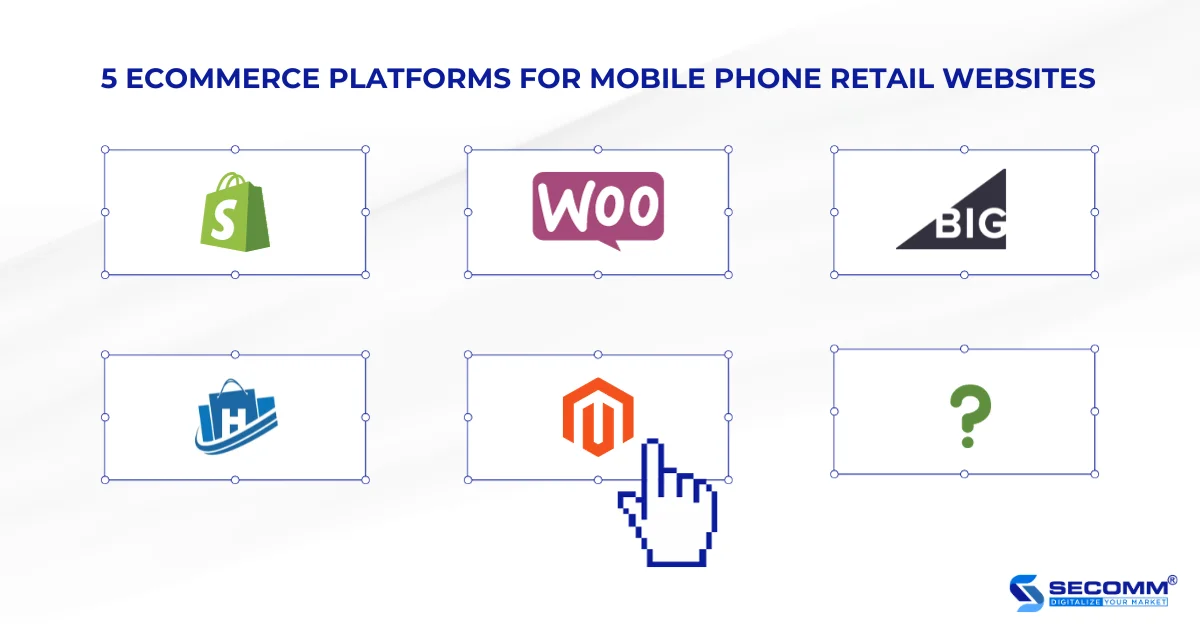
5 ECOMMERCE PLATFORMS FOR MOBILE PHONE RETAIL WEBSITES
In recent times, eCommerce has been increasingly popular in the Vietnamese market and is becoming a potential business model pursued by many enterprises across various industries. Particularly in the mobile phone retail sector, the online market share of mobile phone retail systems is growing rapidly. For instance, The Gioi Di Dong – the largest mobile phone retail system in Vietnam, saw its online market share increase from 11.6% to 17.5% in just one month (from July to August 2021)
Nowadays, many mobile phone retail businesses in Vietnam often choose to implement eCommerce websites as their main channel in online commerce. Thanks to the effective development of website systems, many mobile phone retail businesses have not only seized the opportunity to boost revenue but also achieved sustainable business growth. The common factor contributing to this success lies in the eCommerce platform.
Each type of eCommerce platform has its unique features that can support businesses in developing their online presence. Software as a Service (SaaS) platforms are designed by providers with the entire system pre-built, including hosting, interface, features, and infrastructure maintenance. Therefore, businesses can easily build and operate a website system without much concern for technical issues and without investing too much time and money from the outset.
However, businesses using SaaS platforms will not own the source code and data, and the system’s scalability and integration capabilities are limited. Usage costs may increase over time. On the other hand, open-source platforms give businesses full ownership and control over the source code and data, allowing freedom in designing interfaces and offering high scalability and flexibility. Nevertheless, using open-source platforms often requires a specialized development team and more investment in terms of cost and time.
So, which eCommerce platform will be suitable for mobile phone retail businesses?
The criteria for choosing a platform
User interface and administrative interface
The user interface of an eCommerce system is considered the face and highest scoring aspect in online business. Therefore, besides meeting UI/UX standards and expressing the brand’s characteristics, products, businesses also need to focus on the presentation of product images on the website, ensuring synchronization and clarity.
This ensures a complete and satisfying experience for customers. The admin interface must be user-friendly, allowing easy navigation, control, and management of all data within the system.
A diverse range of eCommerce system features
With online retail of mobile phones, the eCommerce system’s feature set needs to be diverse, ranging from basic to advanced and specialized, aiming to provide an optimal experience for buyers and facilitate the efficient and sustainable development of the eCommerce system.
Some essential functions in the eCommerce website system for mobile phone retail businesses include:
- Basic Functions: Meeting the most basic operational needs of the eCommerce system, such as order management, categories, content, marketing management, customer management, inventory, system management, reporting, checkout, payment, shipping, etc.
- Advanced Functions: Enhancing the consumer experience and expediting the shopping process with features like order tracking, abandoned cart recovery, product suggestions, quick product search, layered product categories, etc.
- Specialized Functions: Addressing specific challenges in implementing eCommerce for mobile phone retail, catering to the unique needs of customer segments and businesses. Examples include Flash sale programs, instalment plans, buy now pay later options, etc.
High integration capability
To have a seamless online business system, businesses often need to integrate eCommerce platforms with other software and technology platforms they are currently using, such as:
- Payment Integration: Integrating various payment methods from domestic to international cards, payment gateways (Paypal, Stripe, OnePay), e-wallets (Momo, ZaloPay), etc.
- Shipping Integration: Integrating international shipping providers (DHL Express, FedEx, UPS, USPS, etc.) and local ones in Vietnam (Giao Hang Nhanh, Giao Hang Tiet Kiem, Ninja Van, etc.). Additionally, order-tracking applications help streamline and operate shipping processes.
- Management Software: Easily integrating CRM, ERP, and POS software for seamless connectivity across all supply channels from offline to online.
- Marketing Management: Integrating additional marketing tools such as email marketing software (MailChimp, Drip…), marketing analytics software (Google Analytics, Google Adwords Keywords…), and social media management software (Buffer, Hootsuite…). Integrating these marketing management tools can help businesses implement marketing campaigns, attract customers, and increase conversion rates to maximize both eCommerce and overall business revenue.
The chosen eCommerce platform must have flexible, seamless, and effective integration capabilities with this software without affecting the execution level of each system. This integration helps businesses overcome the limitations of manual operation and increases automation for both back-office management and sales, ensuring high accuracy and operational efficiency for business development.
High scalability capability
eCommerce platforms need to have high scalability to adapt and grow alongside businesses of all models. Choosing the right platform can accompany businesses from startup and SME stages to becoming large enterprises, and from B2B, B2C, and D2C models to B2B2C, helping save long-term budget while still building a sustainable, efficient system suitable for the business.
High scalability meets all future development needs of the business, such as expanding multiple websites, across countries, currencies, channels, etc. Moreover, platforms with high scalability ensure stable system operation regardless of increasing traffic and transactions over time.
Review 5 eCommerce platforms for mobile phone retail websites
Shopify
Shopify is a well-known giant in the field of building eCommerce systems as a Software as a Service (SaaS). This platform is favoured for its user-friendly nature, quick build time, and low initial costs, making it suitable for many SMEs.
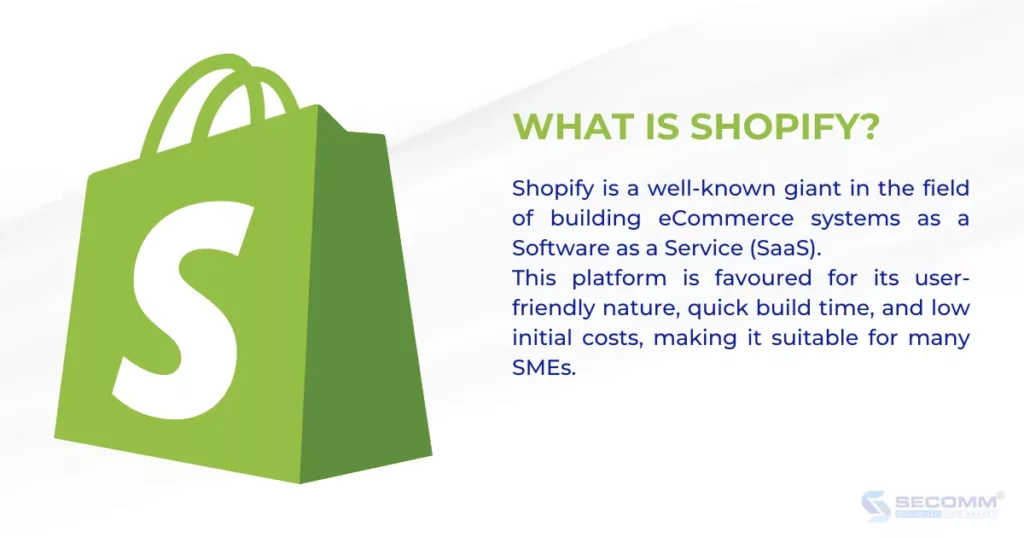
User Interface Criteria
Shopify provides attractive, responsive themes suitable for various industries, including mobile phone retail. While adhering to UI/UX standards, it lacks customization options for businesses to showcase their unique branding.
Admin Interface Criteria
The admin interface is user-friendly on desktops, allowing easy management of the website’s aspects. However, mobile functionality is limited, restricting businesses to perform specific functions on the mobile version.
Functionality System Criteria
Shopify’s functionality system is comprehensive, meeting both the basic and advanced needs of small and medium-sized enterprises. However, accessing advanced features requires additional monthly payments, leading to increasing usage costs. Shopify, however, lacks certain features crucial for mobile phone retail, aside from instalment payment options.
Integration Capability Criteria
Shopify restricts access to the source code, making integration with third-party software challenging. Businesses can only integrate with partner software available on the platform or those directly developed by Shopify.
Scalability Criteria
Scalability on the Shopify platform is limited because businesses cannot modify or upgrade the website source code. Therefore, it’s often used by mobile phone retail businesses in their early stages.
Usage Cost Criteria
Shopify offers various service packages to cater to different business needs, ranging from $29/month for Basic Shopify to $2000/month for Shopify Plus. However, businesses may face limitations in advanced features, necessitating a platform switch for a specialized and sustainable system.
→ Overall Rating based on 5 criteria: 2/5
Shopify is suitable for SMEs that want a cost-effective and quick eCommerce system. However, it falls short in advanced features, specific functionalities, and customization options. Businesses must accept the limitations and be prepared to switch platforms for a tailored and sustainable solution in the future.
WooCommerce
WooCommerce is an open-source CMS plugin for WordPress introduced in 2011, completely free, enabling businesses to turn their WordPress websites into online stores.
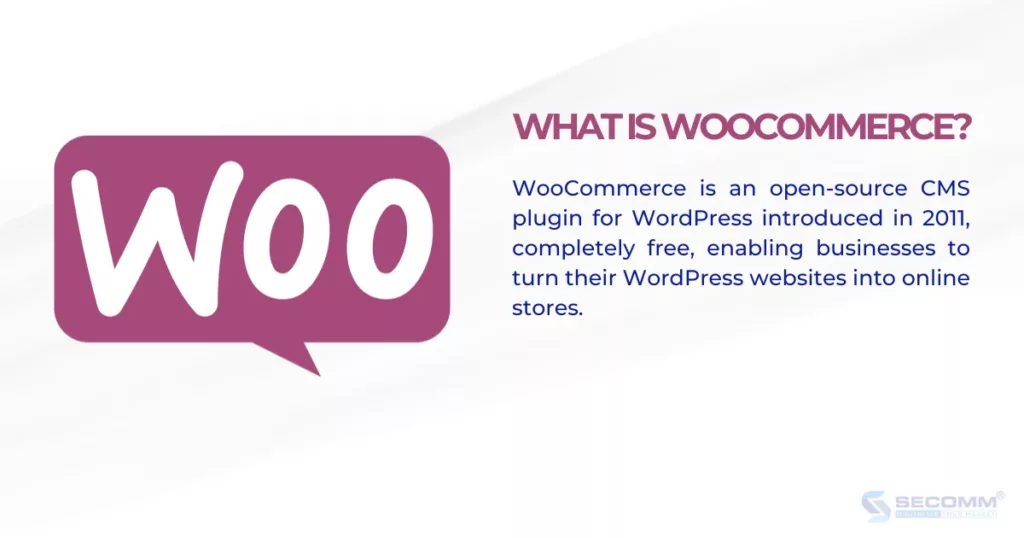
User Interface Criteria
WooCommerce offers a diverse library of templates for mobile phone retail and electronic goods, designed meticulously and user-friendly. This allows businesses to conveniently design and build an eCommerce system from the start without requiring in-depth technical knowledge.
Because WooCommerce is a WordPress plugin, administrators continue to manage the website through the WordPress interface, making it easy for businesses already using WordPress to adapt, use, and navigate the system.
Functionality System Criteria
WooCommerce has many features, both basic and advanced, to support businesses in operating an eCommerce website. However, the platform has some limitations regarding specific features for mobile phone retail. Although it’s open-source, developing unique features on WooCommerce can be challenging and may lead to system instability.
Integration Capability Criteria
Third-party software integrates well with WooCommerce, helping businesses save time, and costs, improve operational efficiency, and automate management processes.
- Payment: Stripe, PayPal, Apple Pay, and Square…
- Shipping: USPS, UPS, and FedEx…
- Management Software: Odoo, Square POS, and WP ERP.
- Marketing Management: Google Listings, Google Ads, Facebook Pixel…
Scalability Criteria
WooCommerce’s most significant drawback is its limited scalability. The platform tends to become unstable and easily overloaded when there are more than 2,000 SKUs or too many themes and plugins on the system.
Usage Cost Criteria
WooCommerce is an open-source platform, so it’s entirely free to use. However, businesses need to pay for additional services such as domain registration ($15), hosting fees ($120/year), and system development costs (ranging from $3,000 to $10,000, depending on system complexity).
→ Overall Rating based on 5 criteria: 3/5
WooCommerce is a good platform for businesses currently using WordPress and looking to develop an eCommerce system. However, the platform has limitations in customization and adjusting unique features. Intervening in the system is likely to cause instability, and there is a high probability that the built-in features are not compatible with the platform. Additionally, to customize the system based on the existing feature set, businesses will need to invest a significant budget and time.
BigCommerce
BigCommerce is a SaaS platform based in the USA with over 600,000 online stores used by consumers worldwide.
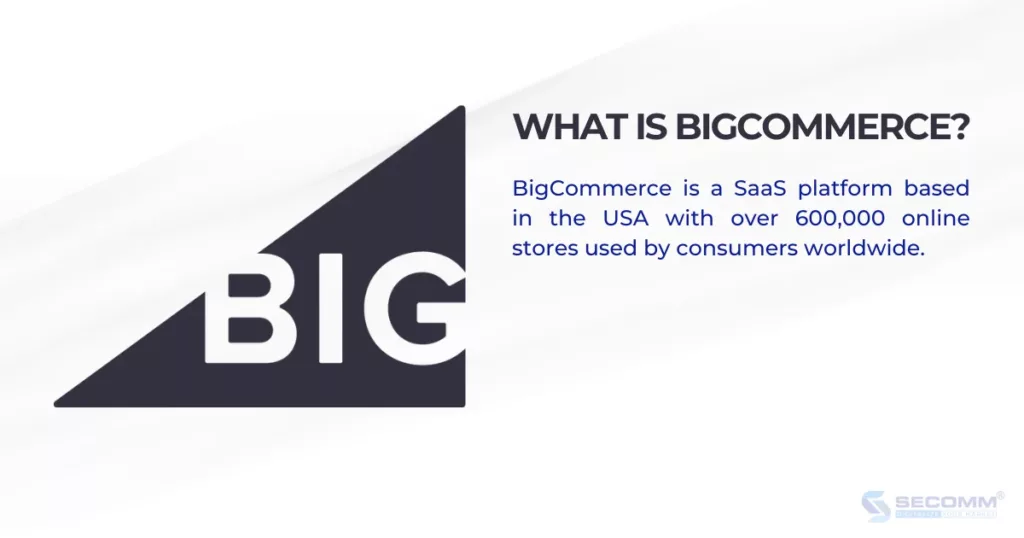
User Interface Criteria
BigCommerce possesses a diverse theme repository with over 160 templates, catering to various industries, including mobile phone retail and electronics. All these templates are designed following UI/UX standards, allowing for easy adjustments to fit the brand.
For the administrator interface, businesses can manage their stores on a real-time and easily trackable screen.
Functionality System Criteria
BigCommerce’s functionality is relatively comprehensive, meeting basic and advanced needs, as well as specific features for mobile phone retail businesses. However, since BigCommerce is a SaaS platform, businesses cannot modify the source code or develop additional features not already available on the platform. Businesses can only use the features provided by BigCommerce or those offered by the platform’s partners.
Some notable advanced and specific features available on BigCommerce suitable for mobile phone retail businesses include multi-currency support, advanced SEO, rating and review features, advanced reporting, and instalment payment capabilities.
Integration Capability Criteria
BigCommerce has a relatively high integration capability, allowing integration with many popular third-party software to support business operations.
Some software that can be integrated with BigCommerce includes various payment gateways (Stripe, PayPal, ApplePay, Checkout), shipping solutions (ShipStation, Amazon Shipping, Easyship, Route), ERP systems (NetSuite ERP, Acumatica Cloud ERP), CRM (HubSpot, Revamp), and marketing tools (email marketing, social media integration).
Scalability Criteria
The system’s scalability depends on the BigCommerce service package that the business is using. The platform can support business expansion into new markets, multiple currencies, and languages. Additionally, BigCommerce can support stable system operations for businesses handling thousands of SKUs.
Usage Cost Criteria
BigCommerce currently supports three bundled solutions and one on-demand solution:
- Standard Plan: $29.95/month, suitable for businesses with sales over $50,000
- Plus Plan: $79.95/month, suitable for businesses with sales over $180,000
- Pro Plan: $299.95/month, suitable for businesses with sales over $400,000
- Enterprise Plan: for large enterprises, and the cost will be based on the online sales volume of the brand.
→ Overall Rating based on 5 criteria: 3/5
BigCommerce is almost a comprehensive SaaS platform for businesses entering the mobile phone retail eCommerce journey. The platform can be suitable for various business models, including B2B, B2C, and B2B2C, depending on the chosen subscription package. However, the limitation of using this platform is that businesses are restricted in their ability to customize functions on the system, limited in annual revenue with each subscription tier, and unable to own the source code.
Haravan
Haravan, founded in 2014, stands as one of the renowned platforms in the Vietnamese market, boasting over 50,000 businesses and consumer brands. It operates as a service platform modelled on Shopify.
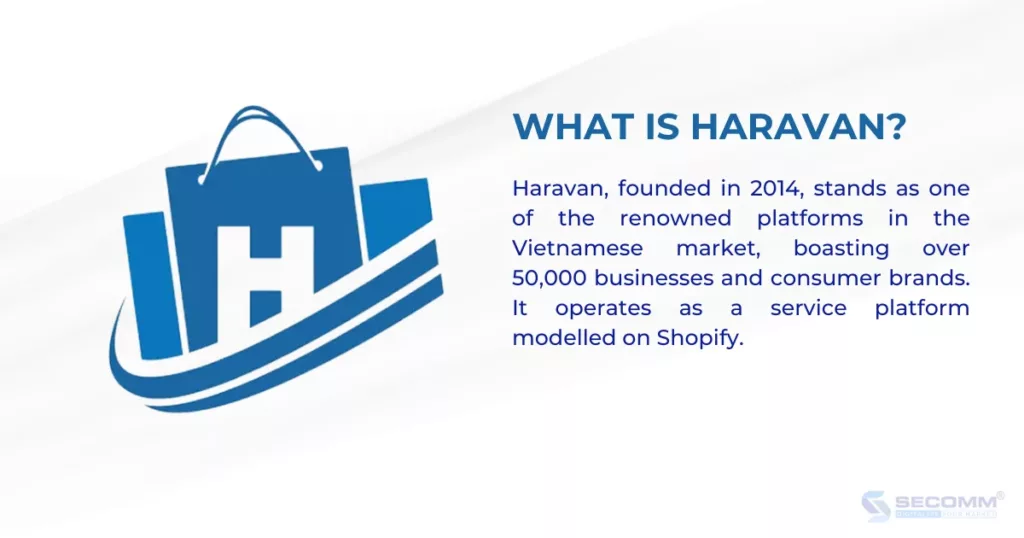
User Interface Criteria
Similar to other SaaS platforms, Haravan boasts a diverse theme repository with over 400 templates, all designed following UX/UI standards. Beyond that, businesses can customize the interface to align with their distinctive brand identity. The admin interface, supporting the Vietnamese language, ensures a user-friendly experience for businesses.
Functionality System Criteria
Haravan offers a comprehensive set of both basic and advanced features, enabling businesses to swiftly establish an eCommerce website. The platform includes specific functionalities tailored for mobile phone retail, such as installment payment options. However, akin to Shopify and BigCommerce, businesses cannot develop additional features beyond what Haravan offers in its repository.
Integration Capability Criteria
Integration with third-party utilities outside Haravan’s ecosystem can be challenging, representing a significant limitation of service-type platforms. However, it does support integration with widely used services in Vietnam, including various payment methods (Momo, VNPay, ZaloPay, etc.), shipping services (Giao Hàng Nhanh, Viettel Post, DHL), and management tools (CRMViet, Teamcrop).
Scalability Criteria
Haravan’s scalability is limited; it supports multilingual and multi-currency features but lacks the capability to expand to multiple websites or efficiently manage extensive data on the platform.
Usage Cost Criteria
To use Haravan, businesses need to pay a reasonable monthly fee ranging from 200,000 VND to 3,000,000 VND, depending on business needs:
- Standard: 200,000 VND/month for individual sellers
- Pro: 600,000 VND/month for businesses wanting to implement Omnichannel
- Grow: 1,500,000 VND/month with the advantage of automating customer care and re-engagement programs
- Scale: 3,000,000 VND/month to build a loyal customer base.
→ Overall Rating based on 5 criteria: 3/5
Haravan is a suitable platform for businesses in Vietnam with limited technology experience and budget constraints. However, as businesses grow, Haravan may not provide sufficient functionality to sustain operations. Eventually, transitioning to more specialized platforms like Magento, WooCommerce, or OpenCart becomes necessary, albeit with challenges such as costs, time, and human resources.
Magento
Magento is an open-source eCommerce platform with deep expertise in online commerce. It currently offers two versions: Open Source (free) and Commerce (paid). Recognized as one of the most comprehensive eCommerce platforms, Magento boasts diverse features, high flexibility, scalability, a diverse ecosystem, and optimal security.
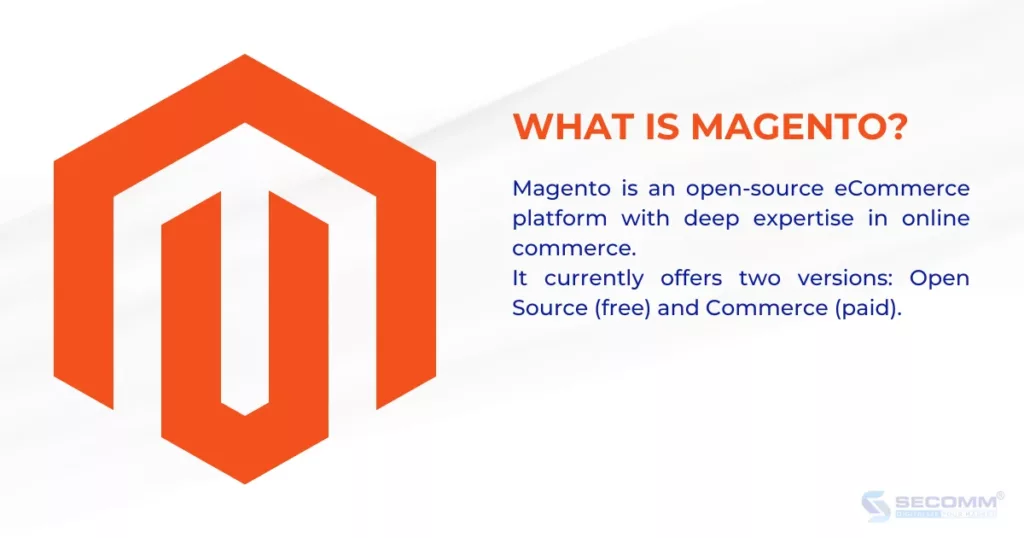
User Interface Criteria
Unlike other platforms, Magento doesn’t have an extensive theme repository. However, each theme is meticulously designed, unique, adheres to UX/UI standards, and emphasizes high aesthetics to convey brand and product values, attracting customers to the system.
Businesses can save costs and time by using available themes, while also having the option to customize for brand identity. Additionally, businesses can fully design their interface, enhancing brand recognition, though this requires careful investment in design time and costs.
For the admin interface, Magento 1 was criticized for being challenging to use. However, Magento 2 introduced a more intuitive dashboard, making navigation easier, user-friendly, and adaptable.
Functionality System Criteria
Magento’s eCommerce platform has a diverse and deep feature system, catering from basic to advanced and specific functions. This allows mobile phone retail businesses to easily and rapidly build and develop their system in the short and long term. Basic functions include Category Management, Content Management, Customer Management, Marketing Management, Order Management, Store Management, System Management, Cart and Checkout, and Reporting & Analysis.
Specialized features include support for multiple languages, currencies, stores, Progressive Web Applications (PWA), Multi-Source Inventory (MSI), ElasticSearch, etc., enhancing the customer experience and accelerating the shopping process.
Integration Capability Criteria
Magento excels in easy integration with third-party software for payments (credit cards, e-wallets, payment gateways, cash on delivery), shipping (Fedex, DHL, local carriers), management software (POS, CRM, ERP), and marketing tools (email marketing, advertising).
Scalability Criteria
Magento ensures stable system operation even with increasing traffic over time or sudden spikes in business campaigns. It can handle up to 500,000 products and thousands of transactions within an hour. Magento supports the expansion of multiple websites for various countries, all manageable on one screen, allowing businesses to access and manage data for multiple websites/stores simultaneously.
Usage Cost Criteria
One significant limitation for mobile phone retailers opting for Magento is the high initial development cost. A fully functional Magento system development is estimated to range from $10,000 to $100,000. Beyond complex and advanced features, the need for an experienced professional team contributes to the higher implementation costs compared to other platforms.
→ Overall Rating based on 5 criteria: 4/5
Magento is a comprehensive platform suitable for mobile phone retail businesses, whether B2B, B2C, or D2C, especially those with an existing customer base and a desire to develop a long-term eCommerce system. With Magento, businesses can continuously develop components of the eCommerce system, ensuring optimal performance and sustainable growth.
Choosing the right platform for eCommerce is crucial for mobile phone retailers. An accurate choice helps businesses shorten development time, save costs, and maximize resources to achieve the highest revenue levels. SECOMM understands the challenges facing mobile phone retail businesses and provides expert advice.
Contact SECOMM now for a free consultation!
 2
2

 8,303
8,303

 0
0

 1
1
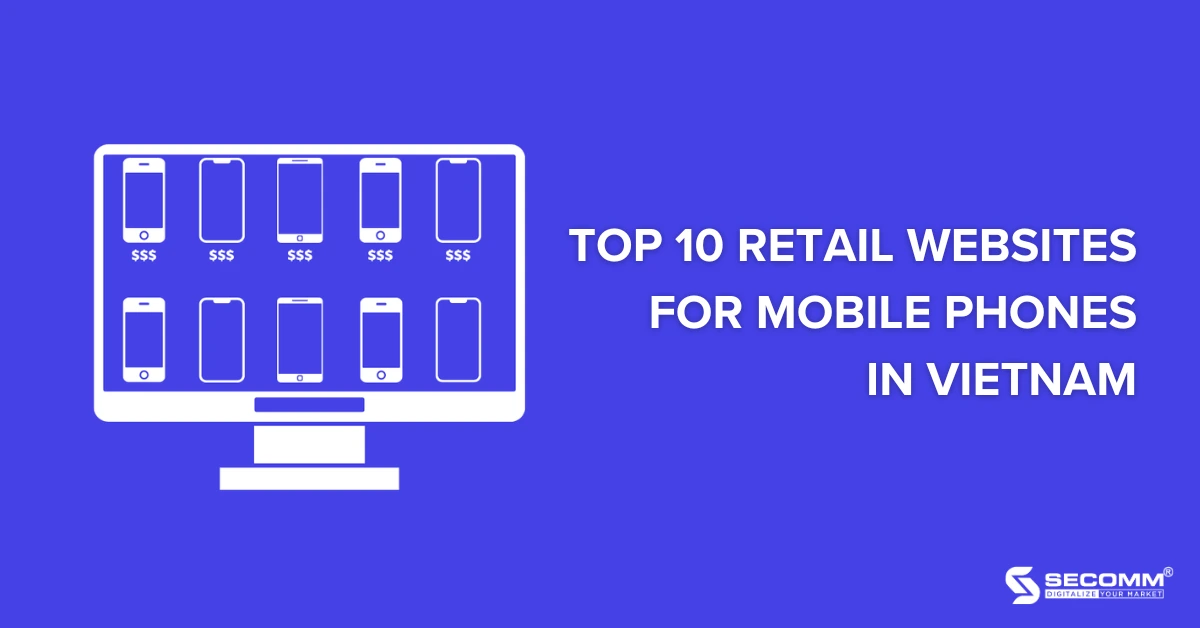
TOP 10 RETAIL WEBSITES FOR MOBILE PHONES IN VIETNAM
The retail market for mobile phones in Vietnam is booming like never before! With 61 million users, Vietnam is currently among the top 10 markets with the highest mobile phone usage in Asia. Furthermore, this market is predicted to grow in 2022 by 47.5% (according to Trendforce).
Taking advantage of this opportunity, many retail businesses in Vietnam have achieved tremendous success and continuously expanded their scale, such as The Gioi Di Dong, FPT Shop, Viettel Store, etc.
To contribute to this success, one cannot ignore e-commerce. Online sales channels such as websites, mobile apps, and e-commerce platforms play an increasingly important role for retail businesses in the mobile phone industry, especially post-pandemic.
According to Debasish Jana, an expert from the market research company Counterpoint Research, online sales of mobile phones have increased compared to the same period last year, accounting for 14% of the total market share. Not stopping there, the growth rate of online mobile phone retail is projected to increase even further shortly, reaching 29% by 2025 (according to Google, Temasek, Bain & Company).
E-commerce helps retail businesses develop their business models and contributes to revenue growth for enterprises.
The Gioi Di Dong
The Gioi Di Dong is a brand under the company The Gioi Di Dong Joint Stock Company, established in 2004. According to Euromonitor International, The Gioi Di Dong is the largest online retail company in Vietnam, holding a 10% market share. It is also the leading retail chain for mobile devices in Vietnam, with approximately 1,000 stores present in all 63 provinces and cities nationwide.
Currently, this retail business is heavily investing in online sales systems such as websites and apps.

- Website: https://www.thegioididong.com/
- Website Traffic: 30.20M/mn
CellphoneS
CellphoneS is a retail system for well-known technology products in Vietnam. Currently, the business has a presence in Ho Chi Minh City, Hanoi, Binh Duong, Hai Duong, Hai Phong, Bac Ninh, Vinh Phuc, Thai Nguyen, and Vung Tau.
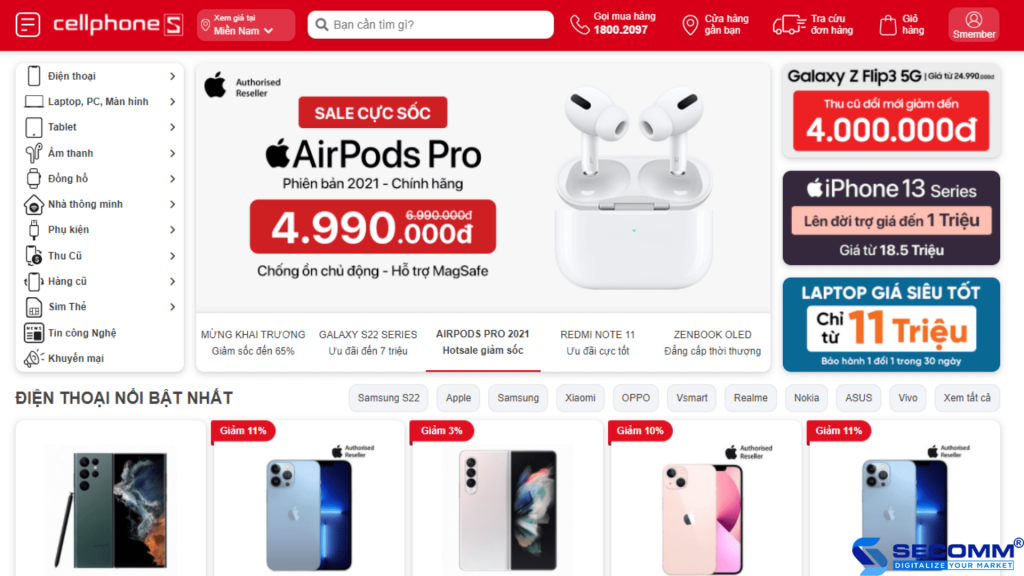
- Website: https://cellphones.com.vn/
- Website Traffic: 9.08M/mn
FPT Shop
FPT Shop is under the ownership of FPT Corporation Vietnam, established in 2012. It is an officially authorized dealer of Apple in Vietnam at the highest level, specializing in providing genuine electronic products. Currently, the retail chain system spans across the country with stores in all 63 provinces and cities.
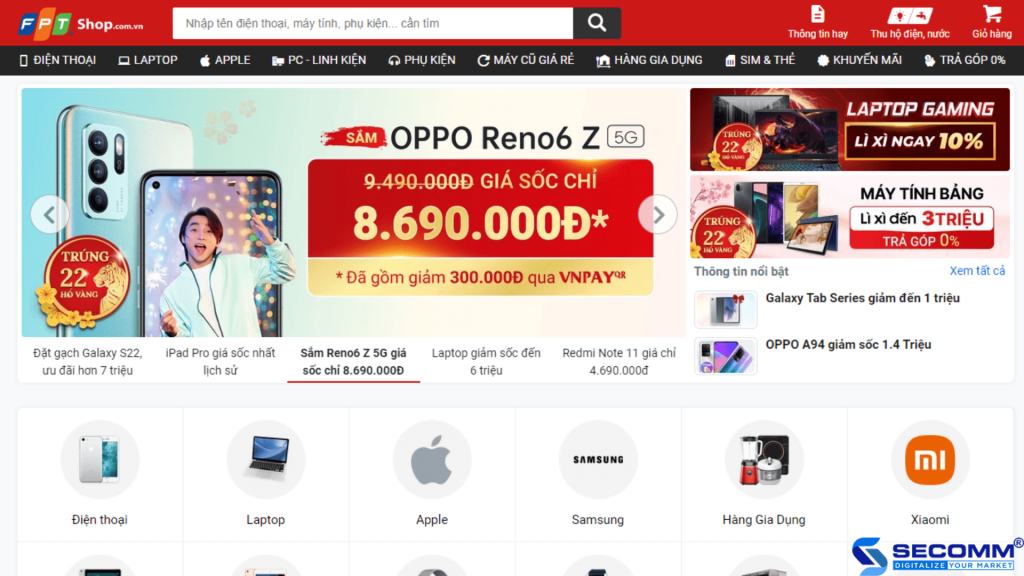
- Website: https://www.fptshop.com.vn
- Website Traffic: 5.933M/mn
Hoang Ha Mobile
Hoang Ha Mobile is a retail system specializing in providing genuine technology products and well-known mobile phones in Vietnam, established in 2014. Currently, the business has over 90 branches spanning from the North to the South.

- Website: https://www.hoanghamobile.com
- Website Traffic: 4.818M/mn
Di Dong Viet
The Mobile Technology Company Limited operates the Didongviet.vn retail chain, established in 2009 as a reputable system specializing in genuine technology products, notably mobile phones, tablets, laptops, accessories, and components.

- Website: https://www.didongviet.vn
- Website Traffic: 1.787M/mn
Viettel Store
Viettel Store was launched in 2009 with thousands of continuously updated products to meet the online shopping needs of customers nationwide. With over 200 stores, Viettel Store’s retail system provides a wide range of high-tech devices and products, including mobile phones, laptops, tablets, and medical equipment.
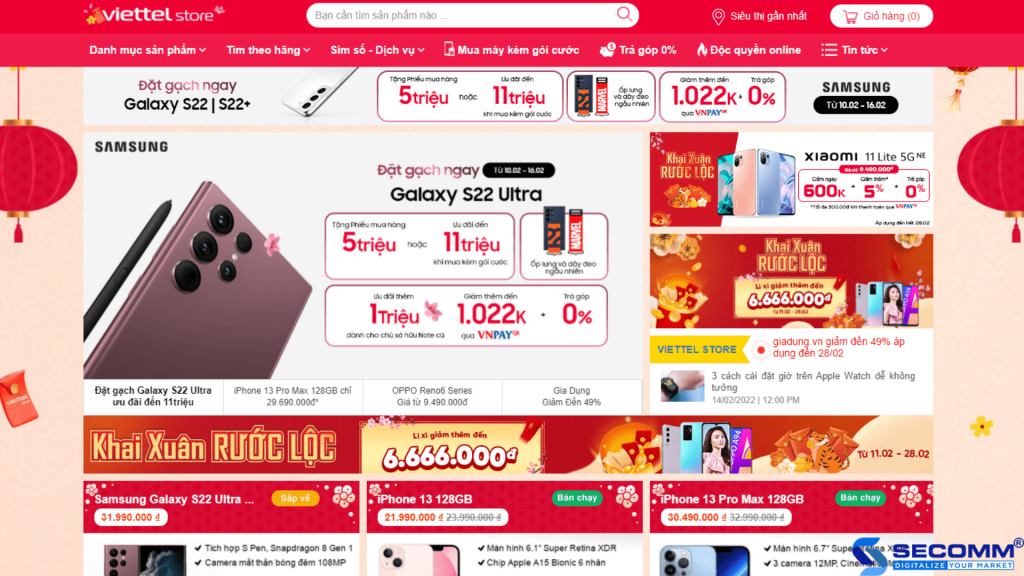
- Website: https://www.viettelstore.vn
- Website Traffic: 1.673M/mn
Sony Store
Sony is one of the most globally renowned brands in consumer electronics, thanks to its revolutionary innovations and product quality. After 21 years in Vietnam, Sony has established a retail system consisting of 11 Sony Shops and Sony Centers, over 160 official dealers, and 70 authorized service stations spread across the country.
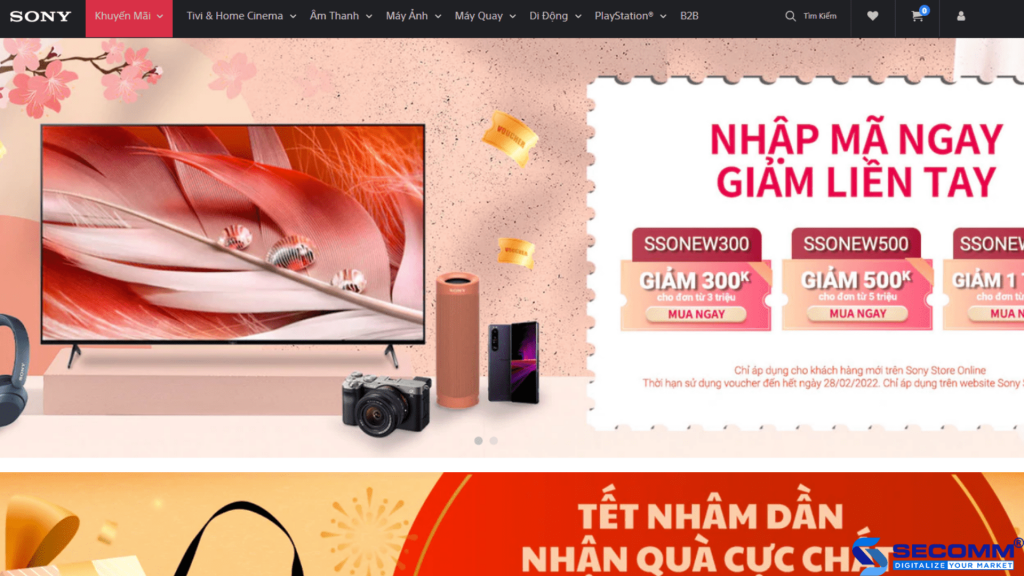
- Website: https://www. store.sony.com.vn/
- Website Traffic: 1.649M/mn
Phong Vu
Phong Vũ is known as a long-established and reputable retail unit in Vietnam since 2007, with over 30 stores nationwide. Specializing in the business of information technology products, gaming and entertainment devices, office equipment, and high-tech devices from various major brands.

- Website: https://www.phongvu.vn
- Website Traffic: 1.479M/mn
Mobile City
Mobile City is one of the popular retailers of smartphones, tablets, and technology accessories in Vietnam, with over 10 years of experience.
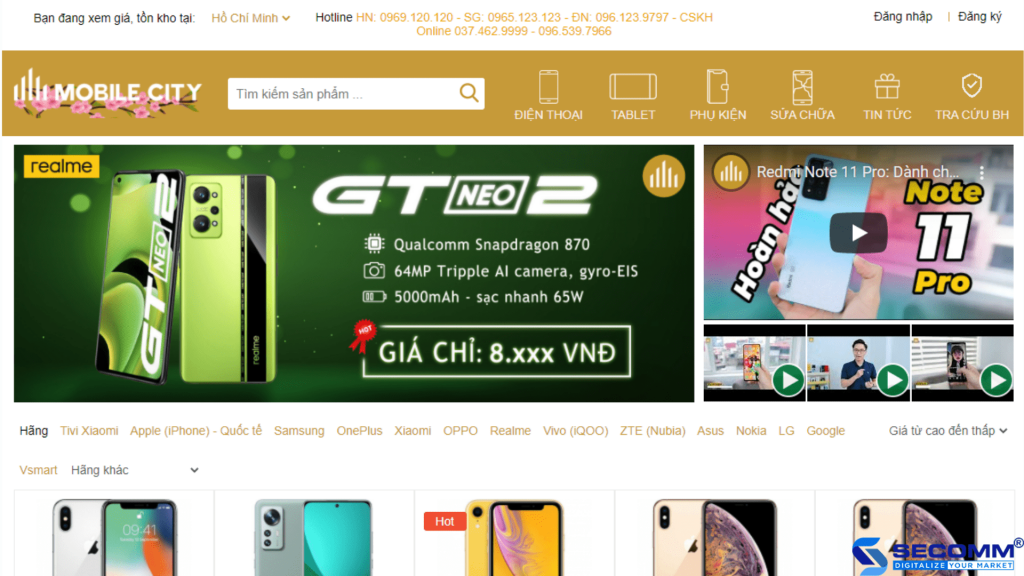
- Website: https://mobilecity.vn/
- Website Traffic: 1.216M/mn
Clickbuy
Clickbuy is a retail system offering well-known technology products in Vietnam, established in 2012. Currently, Clickbuy has expanded to include 5 stores and 2 modern service centers in Hanoi and Ho Chi Minh City.
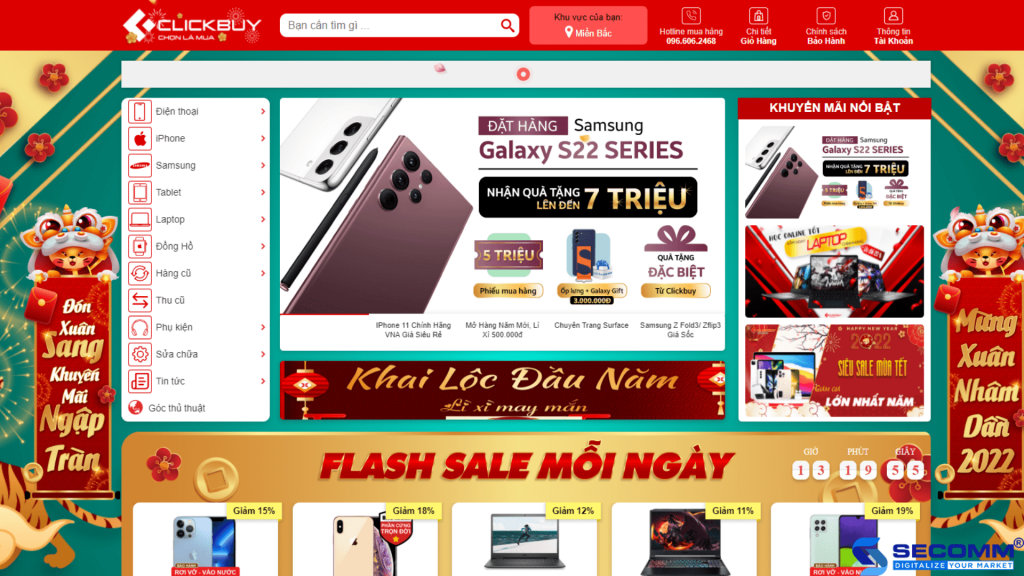
- Website: https://clickbuy.com.vn/
- Website Traffic: 1.190M/mn
Developing E-commerce Solutions for the Mobile Phone Retail Industry
Online business in the mobile phone industry presents numerous growth opportunities. However, to succeed, businesses need a partner with extensive experience in the e-commerce landscape.
With a successful track record in implementing complex e-commerce systems, SECOMM understands the challenges that businesses face.
Contact us now for a free consultation on comprehensive e-commerce system development solutions!
 3
3

 32,558
32,558

 0
0

 1
1
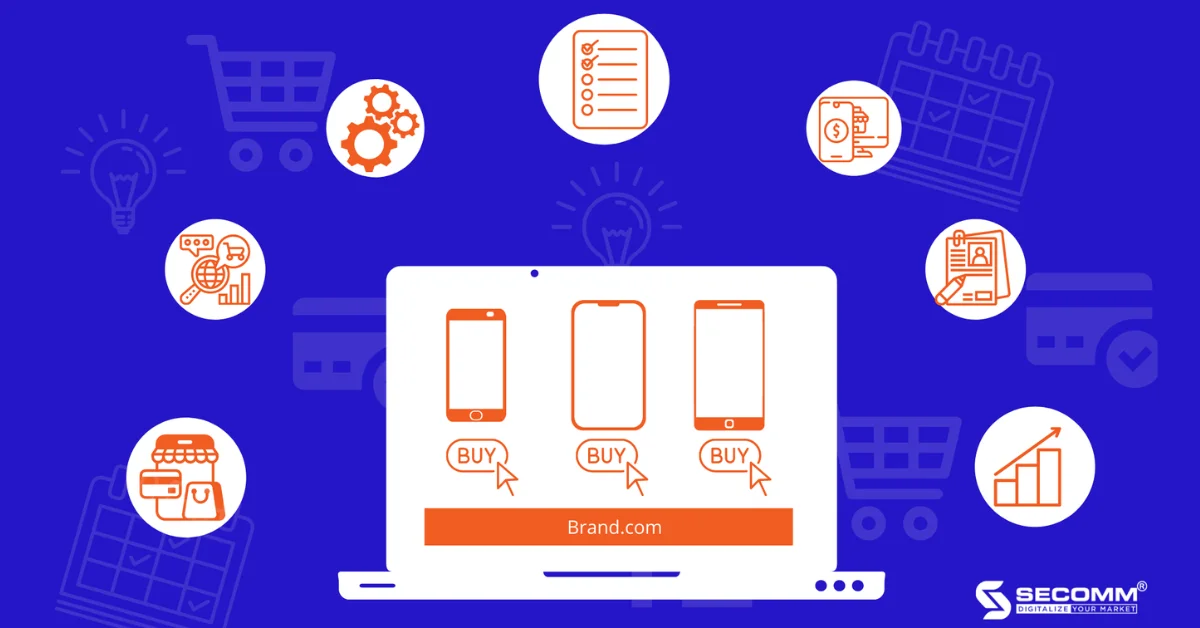
THE JOURNEY OF BUILDING A RETAIL MOBILE ECOMMERCE WEBSITE
The COVID-19 pandemic has shifted shopping trends from traditional stores to online channels. Due to the pandemic, the demand for electronic products such as phones, laptops, and tablets has increased. This has helped mobile phone retail businesses achieve high revenue growth and profitability.
The “leap” into e-commerce has opened up many opportunities for businesses to develop – opportunities to provide a fast and seamless shopping experience for customers, expand sales channels, increase revenue, and establish brand identity.
In this context, owning an e-commerce website is almost a prerequisite for starting a successful online business. An e-commerce website can support businesses in several ways:
- Maximize Revenue: Businesses can add sales channels to expand their business model, increase profits, and avoid limitations on time and space compared to traditional in-store sales.
- Cost Savings: It saves costs related to renting physical space and human resources, and especially reduces dependence on e-commerce platforms.
- Data Collection: Businesses can rely on customer journeys on the system to collect data, then analyze and leverage it to personalize the user experience.
- Enhance Competitive Ability: Utilizing and exploiting the strengths of an e-commerce website with a visually appealing and unique interface will make it easier for businesses to position their brand and attract customers.
- Brand Promotion: It increases trust, professionalism, and accessibility to potential customers.
- These factors highlight the importance of having an e-commerce website for businesses looking to thrive in the evolving market landscape influenced by the COVID-19 pandemic.
Related article: Top 10 retail websites for mobile phones in Vietnam
Though the benefits are plentiful, how can one design a comprehensive e-commerce website for a business professionally and effectively?
Below is the journey to build a comprehensive e-commerce website for a mobile phone retail business with two main stages: (1) building the basic e-commerce website and (2) transitioning to building an in-depth e-commerce website.
Phase 1: Building the Basic Mobile Phone E-commerce Website
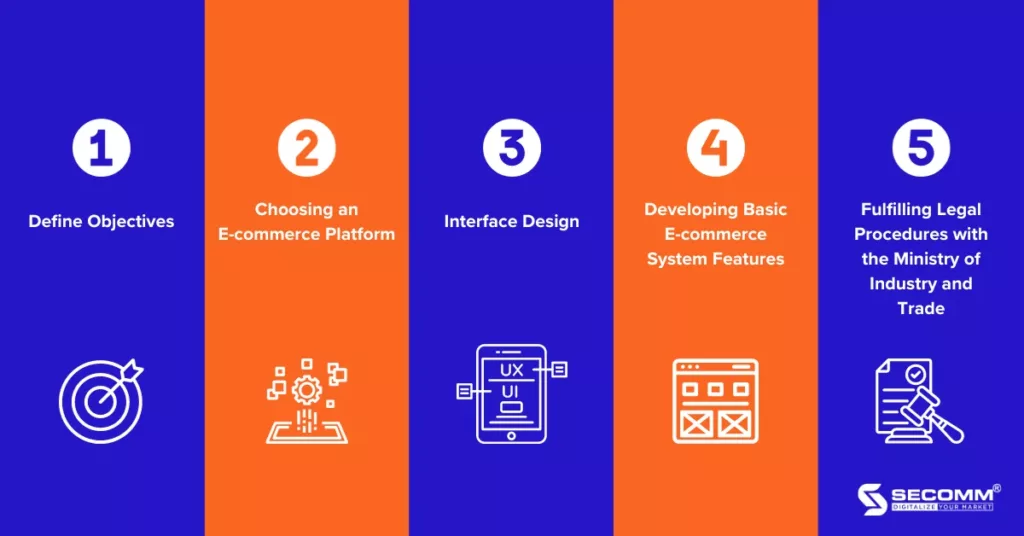
Define Objectives
The first step in constructing an e-commerce website is for the business to determine elements such as objectives, budget, and time for project development.
- Regarding Objectives: Businesses need to review and cross-reference all goals in the E-commerce Business Plan with the overall Business Plan to ensure the correct and effective implementation of E-commerce, assisting in organizing and prioritizing specific objectives in each development stage.
- Long-term objectives play a guiding role, providing a general framework for e-commerce and overall business development. These may include sustainable brand awareness, the brand’s market value, total revenue, etc.
- Short-term objectives help shape strategies with specific tasks and detailed outcomes corresponding to certain timeframes. These may include brand building, increased e-commerce revenue, enhanced competitive capabilities, product quality/diversity, service quality, etc.
- Regarding Timeframes: To ensure the correct execution of objectives, specific time milestones need to be planned with appropriate prioritization in each stage of the e-commerce journey. Once an overall development timeline is established, it becomes easier to determine the payback period and allocate the budget more effectively.
- Regarding Budget: Businesses can prioritize the implementation of essential components of the e-commerce system when the budget is limited, and later expand in subsequent stages. However, if there are sufficient financial resources, businesses can deploy a comprehensive business plan across departments and stages to enhance performance and achieve sustainable development.
After completing the “ideation” for the e-commerce website, businesses can kickstart the project by purchasing suitable hosting and domain names aligned with the products or services the business intends to offer.
Choosing an E-commerce Platform
Once the specific business strategy has been identified, the business needs to carefully consider choosing a platform for building the e-commerce website. Currently, the two most popular types of e-commerce platforms are Software as a Service (SaaS) and open-source platforms.
For SaaS Platforms
With SaaS platforms, businesses can choose from various pre-designed templates and features to build a website through simple drag-and-drop operations, requiring minimal investment in terms of time and development costs. However, with SaaS platforms, businesses do not own the source code and data; they can only utilize the available features of the platform. The flexibility and scalability of the system are limited, and usage costs may increase over time. Some popular SaaS platforms in Vietnam include Haravan, Shopify, Sapo, etc.
For Open-Source Platforms
With open-source platforms, businesses have complete freedom to design the interface according to their requirements. These platforms offer high flexibility and can be customized extensively. Open-source platforms provide a full range of features and additional utilities, supporting sustainable development. Businesses own all the source code and data. However, businesses will need a skilled in-house team or experienced development partners to accompany them, investing time and money in development. Some popular open-source platforms include Magento, WooCommerce, OpenCart, etc.
Interface Design
Businesses can initiate the interface design for the website on the selected platform by using existing templates or themes available on the system. Alternatively, they can customize and design a unique interface that aligns with the brand image and specific preferences of the mobile phone retail industry.
Developing Basic E-commerce System Features
At this stage, the business collaborates with an in-house IT team or a deployment unit to establish fundamental eCommerce features, ensuring smooth sales processes on the system. On both SaaS and open-source platforms mentioned earlier, businesses can choose suitable functions and integrate them into the website. Some common basic features include:
- Category Management: Control over product data, functions, attributes, prices, inventory, images, and videos (brand, price, phone type, performance, memory, special features, design, screen, size, etc.).
- Content Management: Develop and optimize content for CMS pages (origin, brand, product reviews, usage guides in video form, and success stories relevant to business development needs). Store images, customize themes, and design the website.
- Sales Management: Control and operate sales processes, orders, barcode-based payments, and brand-based sales (iPhone, Samsung, etc.). Integration with customer management to ensure warranty times align with customer purchases. Set up payment methods (COD, card payments, e-wallets, payment gateways), and shipping methods.
- Marketing Management: Deploy and manage various marketing programs and campaigns based on seasons and events (Tet, Black Friday, Christmas, Flash Sales, etc.), especially during product launches by major companies like Samsung, Apple, and Oppo.
- Customer Management: Manage and collect customer information for personalized user experiences, post-purchase customer care, or collaborate with marketing campaigns to attract returning or potential customers.
- Inventory Management: Proactively control the number of available phones in stock (grouped by type, brand, product code, and country of origin).
- Reporting & Analysis: Exploit data and measure performance using tools like Google Analytics, Facebook Pixels, and Google Tag Manager.
- System Management: Maintain a secure and stable eCommerce system. Grant administrator permissions to manage and review the best security practices. Additionally, the platform may offer tools for regular management and maintenance to support stable system operations.
Fulfilling Legal Procedures with the Ministry of Industry and Trade
A mandatory criterion for the official operation of a business’s eCommerce website is the completion of legal documents following regulations. According to Decree 52/2013/ND-CP by the Government, individuals or organizations owning eCommerce websites for selling goods are required to notify or register with the Ministry of Industry and Trade on the eCommerce Management Portal.
Businesses can either complete the registration process themselves or enlist the services of law firms that provide related services.
Phase 2: Developing a Comprehensive eCommerce System
Typically, a basic website may only support a business in its initial stages and face challenges as the business model evolves. Businesses gradually realize the need to develop a more specialized eCommerce system to enhance service quality and improve the overall experience for both customers and the business itself. The development of a sophisticated system requires businesses to be more prepared in terms of time and costs compared to the initial phase.
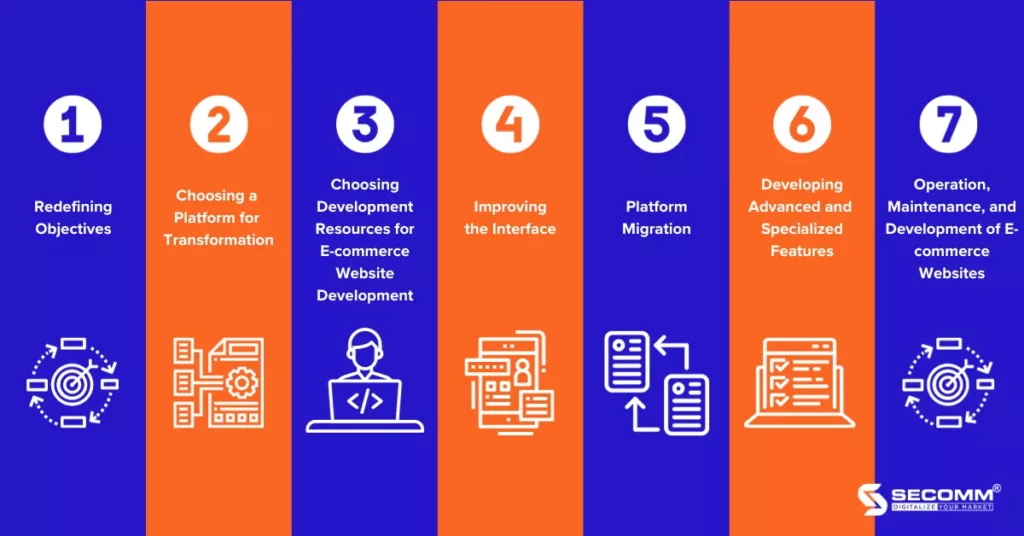
Redefining Objectives
Similar to developing a basic eCommerce system, the first step in developing a sophisticated e-commerce website is for the business to redefine its objectives, costs, and timelines for the project. It is crucial to explore specific features and advancements within the industry. This allows the business to plan a detailed and accurate development strategy that aligns with its business model.
Choosing a Platform for Transformation
To develop a deep eCommerce system, businesses should opt for open-source platforms such as Magento, WooCommerce, OpenCart, etc. Open-source platforms can best meet the expanding system needs and sustain development alongside the business. However, besides the drawbacks of high development costs and an extended construction period, businesses also need an experienced IT team to effectively utilize these platforms.
Criteria for Platform Selection at This Stage:
- User Interface (UI) and User Experience (UX) Development
Allows the development of a standardised user interface that reflects the brand’s characteristics and showcases product images clearly and cohesively.
Enhances brand identity and differentiation.
The admin interface should be user-friendly, facilitating easy navigation, control, and management of the entire system’s data.
- Basic and Advanced Features
The system should support basic functions and be flexible enough to accommodate the development or integration of advanced and specific features.
This flexibility ensures stable business operations in the long term and the ability to adapt to evolving business models.
Seamless integration with other software without compromising the performance of individual systems.
- Scalability
High scalability to adapt and grow alongside the business, catering to various business models.
Cost-effective long-term budgeting while constructing a sustainable and efficient system suitable for the business.
The ability to expand, whether it’s adding multiple websites, operating in multiple countries, dealing with various currencies, or managing multiple channels.
- Extensibility
Ensures the system can efficiently meet the evolving needs of the business.
Can extend to multiple websites, support internationalisation, handle diverse currencies, and manage various sales channels.
Ensures stable system operation regardless of increasing web traffic and transaction volumes over time.
Choosing Development Resources for eCommerce Website Development
To build a sophisticated eCommerce website, businesses can either establish an in-house team or collaborate with external development partners. In both cases, a skilled and experienced workforce with a professional work ethic is essential.
In-House Team:
- Provides control and flexibility in managing daily tasks, timelines, and data.
- Allows the business to have direct oversight of its data and a clear understanding of product values.
- Challenges include limited manpower depending on the company’s size, restricted ideation due to internal expertise, and potential development limitations.
External Development Partners:
- Collaboration with eCommerce system development experts facilitates a smooth platform transition.
- Businesses don’t need to worry about the intricacies of the transition process as external developers offer optimal support.
- However, there might be a trade-off between having 100% control over the development process and the limitation of collaboration.
Recommended Service Providers: Several service providers specialize in deploying advanced eCommerce systems. Some notable examples include SECOMM, SmartOSC, Co-Well Asia, Isobar, and Magenest.
Choosing between an in-house team and external partners depends on the business’s specific needs, resources, and preferences. Each option has its advantages and challenges, and businesses must carefully evaluate their circumstances before making a decision.
Improving the Interface
While transitioning to a new eCommerce platform, businesses have the flexibility to retain their current website interface or redesign it for an enhanced user experience and improved brand positioning. Redesigning involves adjusting existing themes to save time and budget. However, some businesses opt for a custom redesign to meticulously tailor the interface to their specific needs, which may require a higher investment in terms of time and budget.
Platform Migration
Platform migration is a crucial step in building a deep eCommerce website. Automation is typically used to minimize errors during the transition. Businesses need a comprehensive plan encompassing features, data, and scenarios to ensure a smooth and effective transition. The process begins with data extraction from the old system and recording it into the new system.
Post-migration, thorough testing is essential to verify that all components and data have been accurately and adequately transferred according to the plan.
Developing Advanced and Specialized Features
When constructing a deep eCommerce website, businesses must introduce advanced and specialized features to support business model expansion, enhance competitiveness, adapt to market changes, increase revenue, and improve the shopping experience. Some advanced features for eCommerce and mobile retail may include Buy Now Pay Later, Flash Sales, and advanced product search functionalities.
Continuous learning and staying informed about necessary features are crucial for system development. This can be achieved through online applications, an in-house development team, or external development experts. After outlining the development plan, collaboration with design experts to create a system model is essential. The subsequent step involves programming features based on the approved plan. Before deployment, thorough testing, based on the requirements specification document, is conducted to update test scenarios and log errors using error management tools.
Operation, Maintenance, and Development of eCommerce Websites
After developing an eCommerce website, regular maintenance, care, and updates are necessary to ensure continuous online business operation, seamless system operation from online to offline, and optimal user satisfaction. Ongoing research is vital to optimize and develop the website to create a satisfying and comfortable shopping experience.
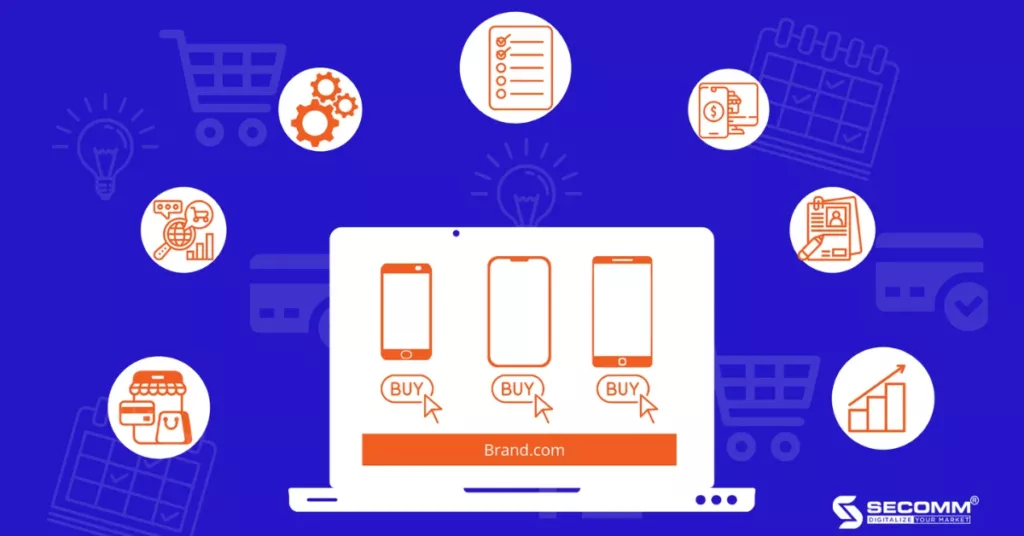
In summary, a comprehensive eCommerce website is crucial for the current and future success of mobile phone retail businesses. Building such a website involves a meticulous process, and each step is critical. Businesses can contact SECOMM for free consultations on comprehensive eCommerce website solutions tailored to mobile phone retail businesses.
 2
2

 9,524
9,524

 0
0

 1
1





